This guide to ferries in Greece will help you easily plan a trip to the Greek islands. Includes information about Greek ferries, how to book online, and more!
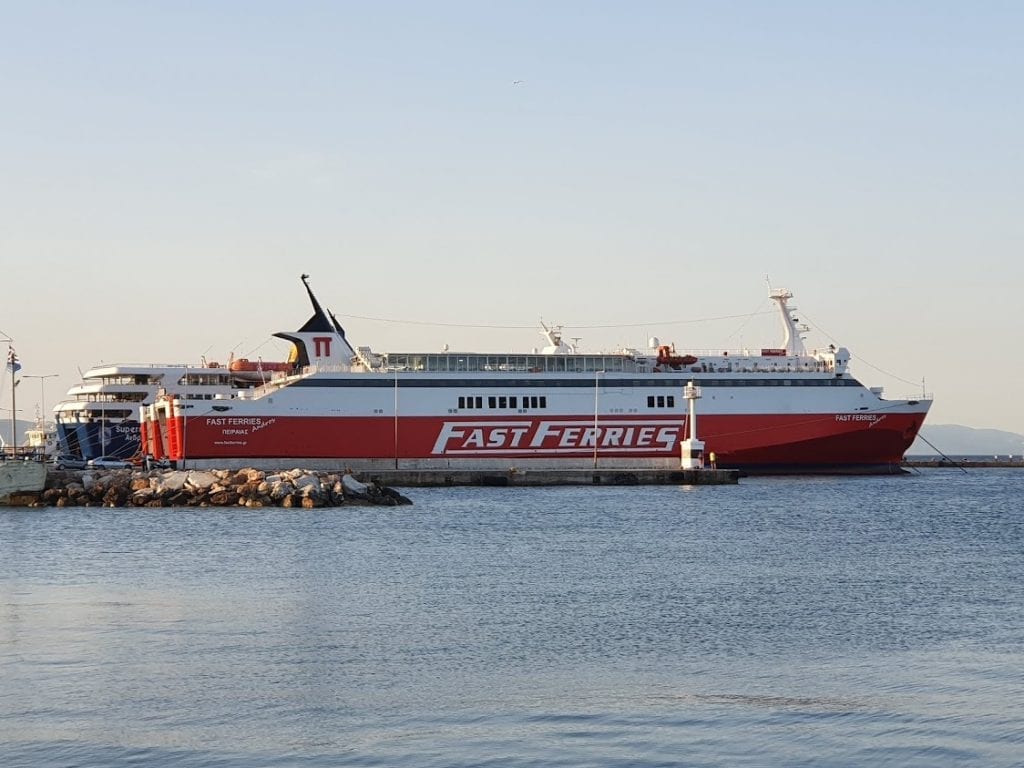
Greek Ferry Guide
If you are visiting Greece on vacation, chances are that you will get one of the numerous ferries in Greece. What are these ferries like though?
This guide aims to introduce you to Greek ferries, and help you choose which one to take.
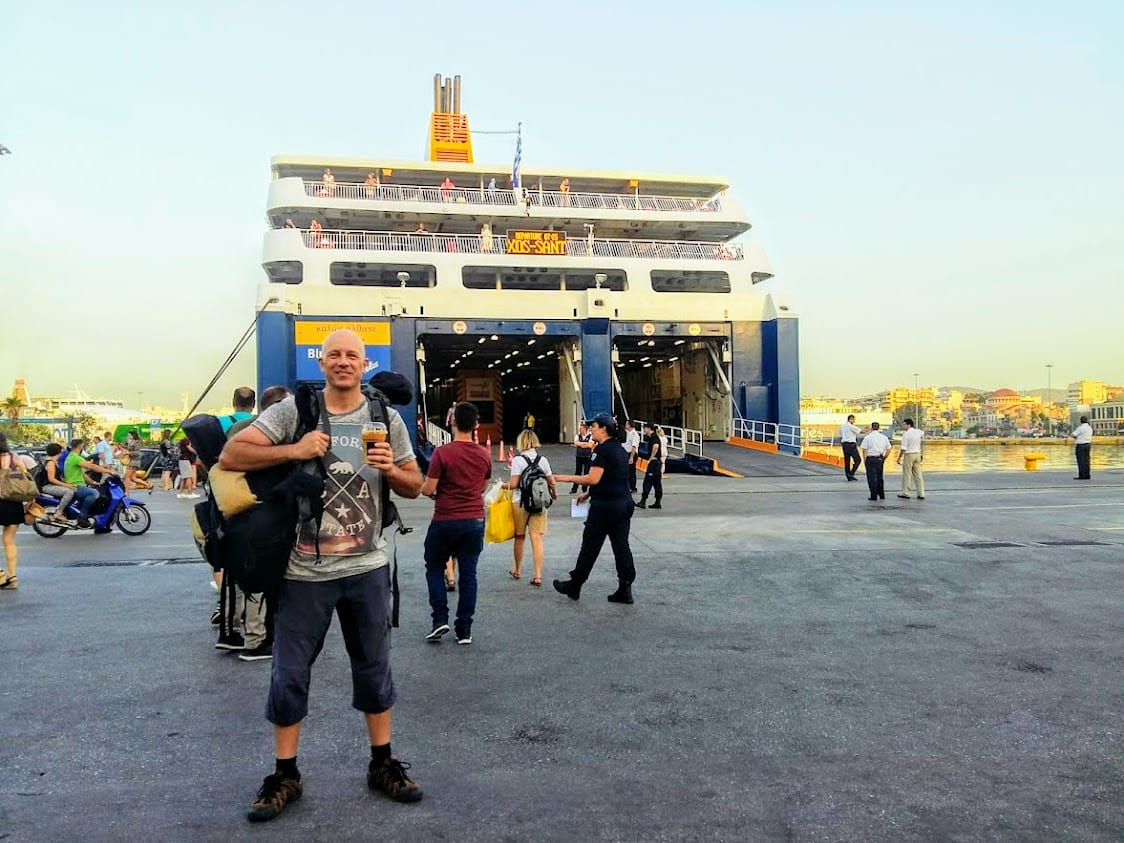
Before you dive in, you should know that this guide is perhaps the most ridiculously in-depth guide to Greek ferry island hopping there is! It includes tips and advice from our years of Greek island hopping, as well as information about practically every ferry in Greece!
Overwhelmed already? If you've arrived at this page and simply want to book a ferry ticket in Greece online, click here >> Ferryhopper
If you want to learn more about Greece ferry travel though, read on!
Note: We can’t thank enough the amazing Dimitris Mentakis who graciously offered us some of his fantastic photos to use in our articles. He is incredibly knowledgeable and passionate when it comes to ferries in Greece, and his photos are in hundreds of Greek articles. Thanks Dimitris!
Where do Greek ferries travel to?
Ferries travel pretty much everywhere in Greece. They connect the islands with the mainland, and they travel between islands in the same island group. They also connect certain island groups with each other.
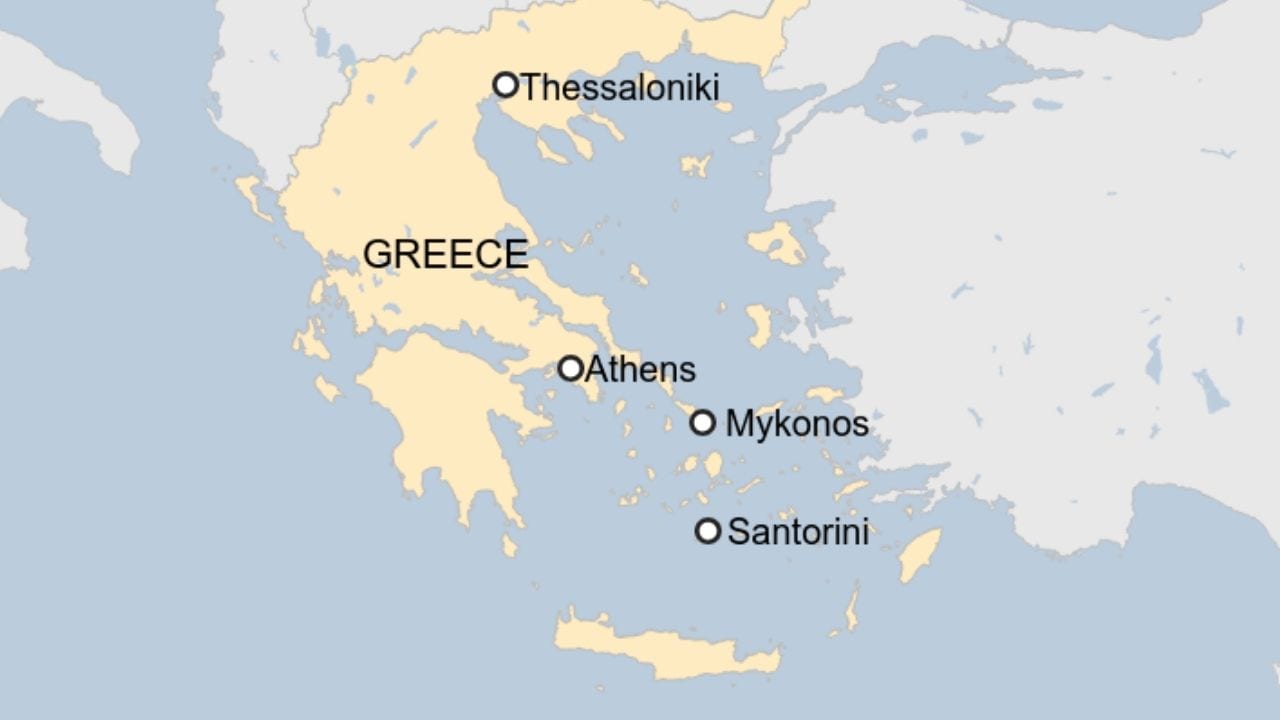
The Athens – Mykonos – Santorini combination is a popular travel combination in Greece, but there are countless other possibilities.
In addition, a number of ferries travel between Greece and the nearby countries, such as Italy and Turkey. The ferries going to Italy may stop at a few Greek ports on the way.
Ferry itineraries in Greece vary by season. There are more routes in summer, when high-speed ferries also operate on certain routes. In winter, many of these ferries stop running, and bigger, slower ferries operate instead.
Tickets for most of these ferries can be booked in advance. Our favourite website to compare Greek ferries and book ferry tickets in Greece is Ferryhopper.
Ferries from Athens ports to the Greek islands
The capital city, Athens, has three main ports, Piraeus, Rafina and Lavrion. They are all easily accessible from Athens by public transportation or taxi.
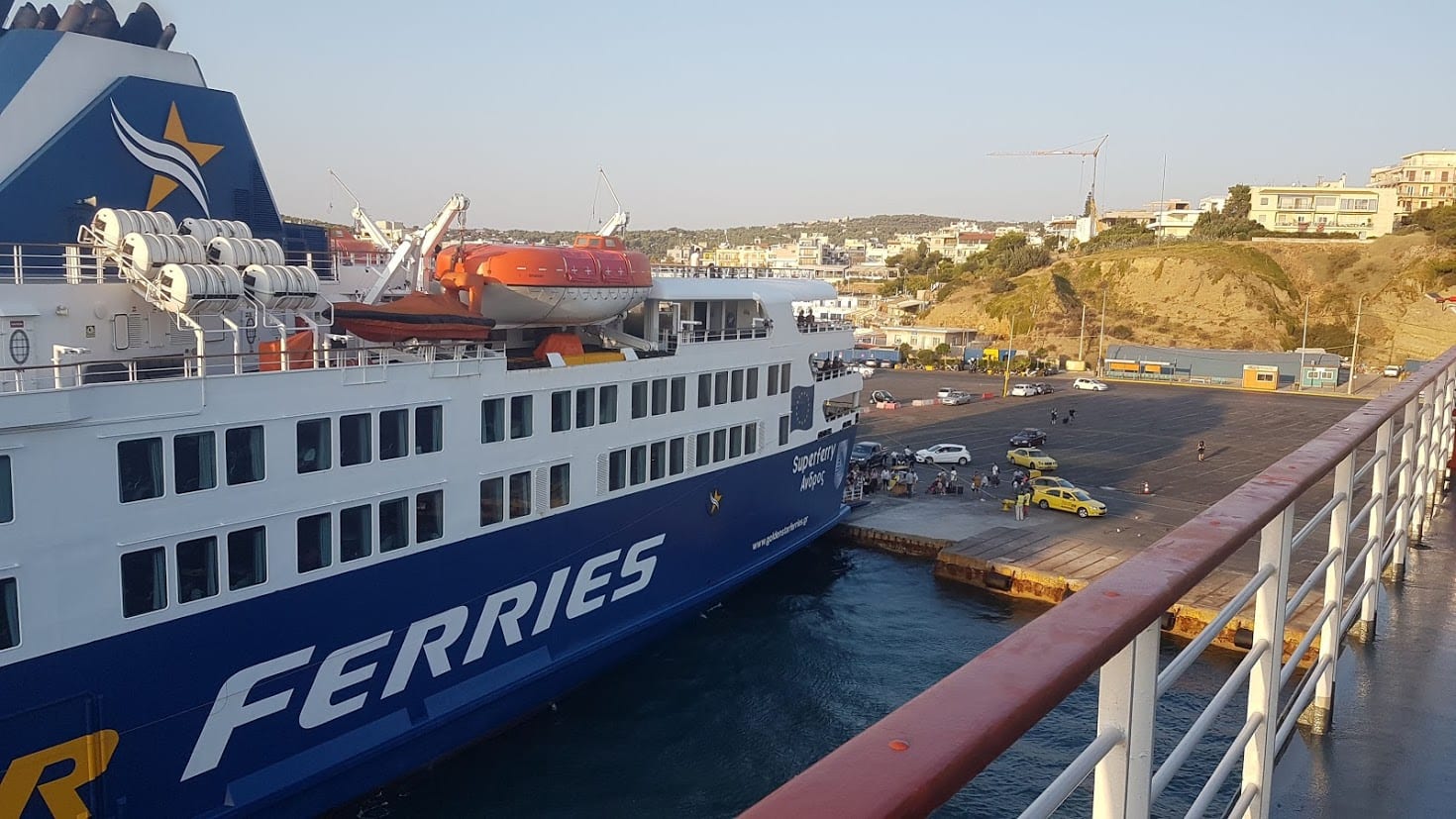
First time visitors to Greece may find it easier to arrange connections with Greek ferries with pre-booked taxis. I recommend Welcome Taxis.
Ferries departing from the Athens ports connect the capital with the following island groups:
- Hydra, Spetses and the Argosaronic islands
- Santorini, Mykonos, Milos, Naxos and all the other Cyclades islands in Greece
- Rhodes, Patmos and the rest of the Dodecanese
- Chios, Lesvos and the Northeastern Aegean islands
- Greece’s biggest island, Crete
- Evia, which can also be reached by land
It is possible to travel between some of these island groups by ferry. As an example, Crete is directly connected to many of the Cyclades islands. Similarly, some of the Cyclades are connected to the Dodecanese, and to certain Northeastern Aegean islands.
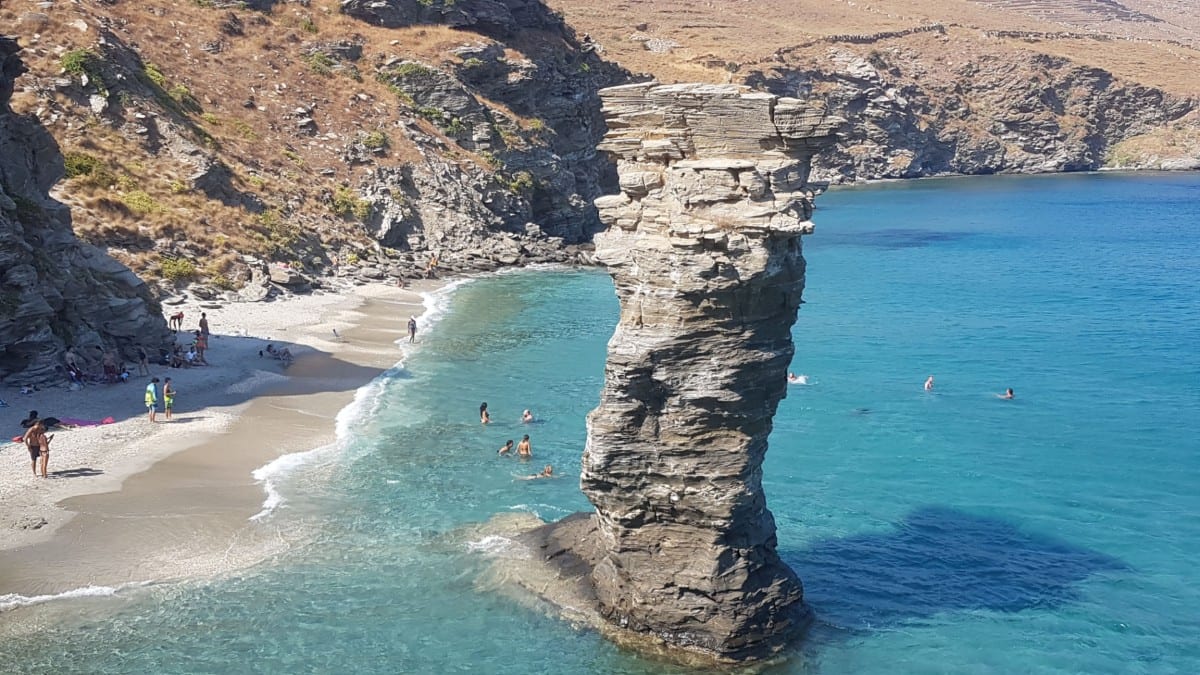
It is not always possible to travel directly between islands of the same group. Even islands that look very close on the map may not be directly connected at all. For instance, the increasingly popular island of Antiparos can only be reached through the island of Paros.
In other cases, islands within the same group may only be directly connected a few times per week. A good example are Sifnos and Syros, both in the Cyclades.
You can check itineraries and book your tickets at Ferryscanner
Ferries departing from mainland Greece
Not all islands are accessible via ferries departing from Athens, but there are other ports in mainland Greece.
The Sporades islands, including Skiathos and Skopelos, can be reached through mainland Greece. You’d have to leave from Volos or the small port of Agios Konstantinos near Kamena Vourla. The Sporades are also connected with Evia island.
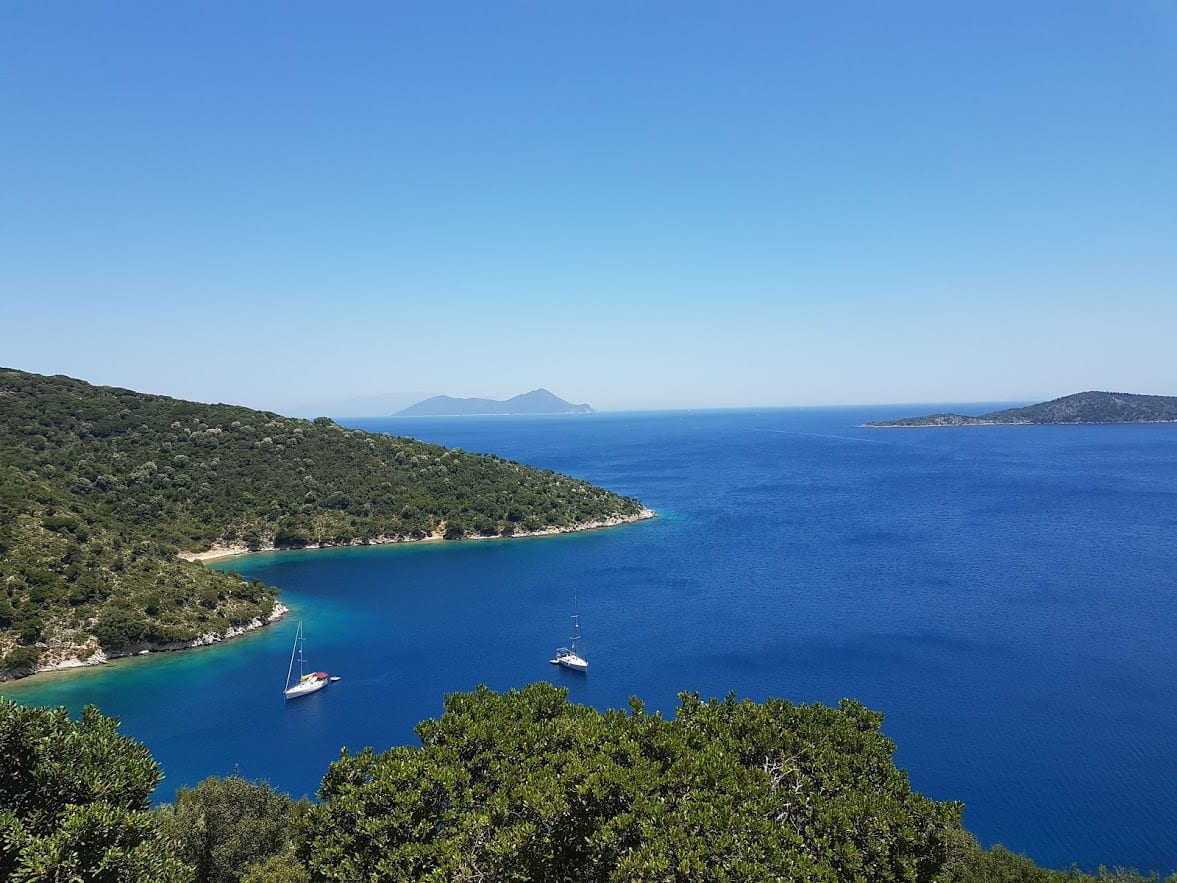
The Ionian islands are a separate group, located west of mainland Greece. They can be approached on ferries from Patras, Kyllini and Igoumenitsa in Western Greece. For people pushed for time, flying might be easier.
Finally, certain islands can also be approached on ferries from the northern ports. Kavala port is connected with islands like Lemnos, Lesvos, Chios, and certain islands in the Dodecanese. Ferries from Alexandroupolis port depart for Samothraki island.
Can you book all Greek ferries online?
When it comes to booking ferries in Greece, most main routes can be booked online.
Apart from the Greek ferry routes mentioned above though, there are hundreds of other ferry services in Greece. As many of those boats are small, you may not be able to find much information online.
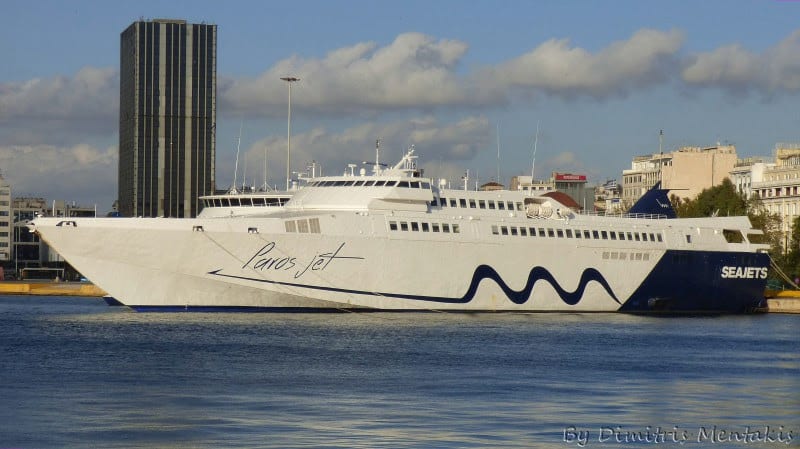
As an example, the popular Paros – Antiparos route does not appear on search engines. We assure you that this route is served by two different ferries, many times a day.
For such routes, you can only get your tickets in person, at the port. These vessels are rarely full, so you will generally get a ticket for the next ferry available.
Similarly, many around-the-island boat trips cannot be booked online. You might be able to contact the captain before your arrival, however it’s not always necessary.
In most cases, you will be able to book a last-minute trip around the island as soon as you arrive on the island, or even the evening before your trip.
Tip – if you are interested in a boat / sailing trip during the peak season, consider the meltemi winds. These are strong seasonal winds that can occasionally disrupt services. Even if the boat departs, you might not want to be on it on a very windy day!
Can I get an e-ticket for a Greek ferry?
Many ferry companies in Greece offer an e-ticket option. This means that you can buy your ticket and either download it on your phone or get it printed if you prefer. This is very convenient, especially if you are buying your boat tickets when you are in Greece already.
At the time of writing (summer 2020), some companies don’t offer an e-ticket option. This means that you can book your ferry ticket online, but you would need to collect your ticket at the port prior to your departure.
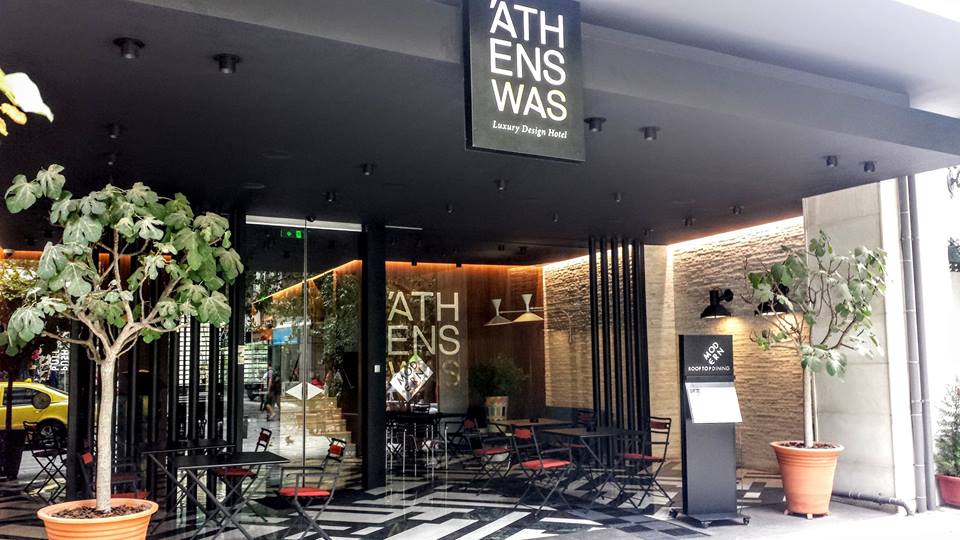
Alternatively, if you are staying at a hotel in Athens before your island trip, Ferryhopper can deliver them to your hotel for a small fee.
In all cases, check each company’s policy at time of booking, as these tend to change from time to time.
To get your ticket for the Greek islands, click here: Ferryhopper Greece
What seating options do I have on Greek ferries?
Seating options on Greek ferries vary widely and depend on the type of vessel.
Smaller, faster ferries only have indoor seating options. Sometimes there may be more than one type of seat, such as standard, business and VIP. While some people might find the upgrade more comfortable, it depends on the ferry.
Medium-sized highspeed ferries also have reserved indoors seating. Again, there are more than one types of seats. If comfort is an issue, you might want an upgrade, especially if you are travelling in peak season. You may be able to stand on the deck for a while, but in general you won’t find designated seating areas on the deck.
Finally, the conventional passenger / car ferries have all sorts of seats. The economy / deck option gives you the right to sit anywhere on the deck, or in designated indoors areas. If you aren’t prepared to fight for your seat, booking reserved “airplane” seats might be the best option for you. You will have your own seat and will still be able to walk around most areas of the ferry.
For longer trips, or on overnight routes, you could also consider getting a cabin. There are different types of cabins, which have anywhere from one to four beds. The most luxurious (and expensive) options are normally cabins with a sea view.
How fast do Greek ferry boats travel?
There are many different types of ferries in Greece, travelling at different speeds. Rather than kilometres or miles per hour, ferry speed is measured in knots. One knot is 1.852 kms or 1.15 miles.

Most conventional ferries run at a speed of 20-25 knots per hour, which translates to 37-45 kms / 23-29 miles per hour.
By comparison, highspeed vessels can reach 38-40 knots per hour, or 70-74 kms / 44-46 miles per hour. Some of them, however, travel a lot faster. One example is the Worldchampion Jet operated by SeaJets – more on this below.
Can you get food and drinks on Greece ferry services?
Ferries connecting the Greek islands have a range of facilities. Generally speaking, the smaller ferries would have a snack bar and café. The larger ones that make longer trips have also fully functional restaurants with many different meal choices.
Coffees, snacks and meals prices are slightly inflated, but all things considered they are not too expensive. You can always bring your own snacks though, especially if you are following a specific diet.
As an indication, a coffee would cost 3-4 euro and a cheese pie or sandwich could be around 3 euro. A seated meal might be around 10 euro, though some ferries have more upmarket options. Water price is regulated by the government, so a small bottle costs 50 cents.
Related: Best Road Trips Snacks
Are there any toilets on Greek ferries?
Well of course! All ferries listed in this article have toilets. In our experience they are mostly clean, and in our trips in the past few years there was toilet paper at all times. However, this may change occasionally – and like anywhere in Greece, it doesn’t hurt to carry some tissue just in case.
Some ferries also have baby changing facilities and even showers. Cabins have their own private shower and toilet facilities.
Do Greek island ferries have Wi-Fi?
Many of the larger ferries have wi-fi services, though it’s not always free. It’s best to check the specific ferry you are interested in.
Also, remember that the ferries will occasionally be far from the mainland. Don’t expect the signal to be great. Even better, take the chance to unplug, sit on the deck and look at the beautiful blue sea!
Can I bring my car on a ferry in Greece?
All bigger ferries, as well as many of the high-speed ones, carry vehicles. The boarding and unboarding procedure can be quite chaotic, and perhaps even intimidating. There is generally lots of shouting, as the ferry employees try to get everyone on and off board as quickly as possible.
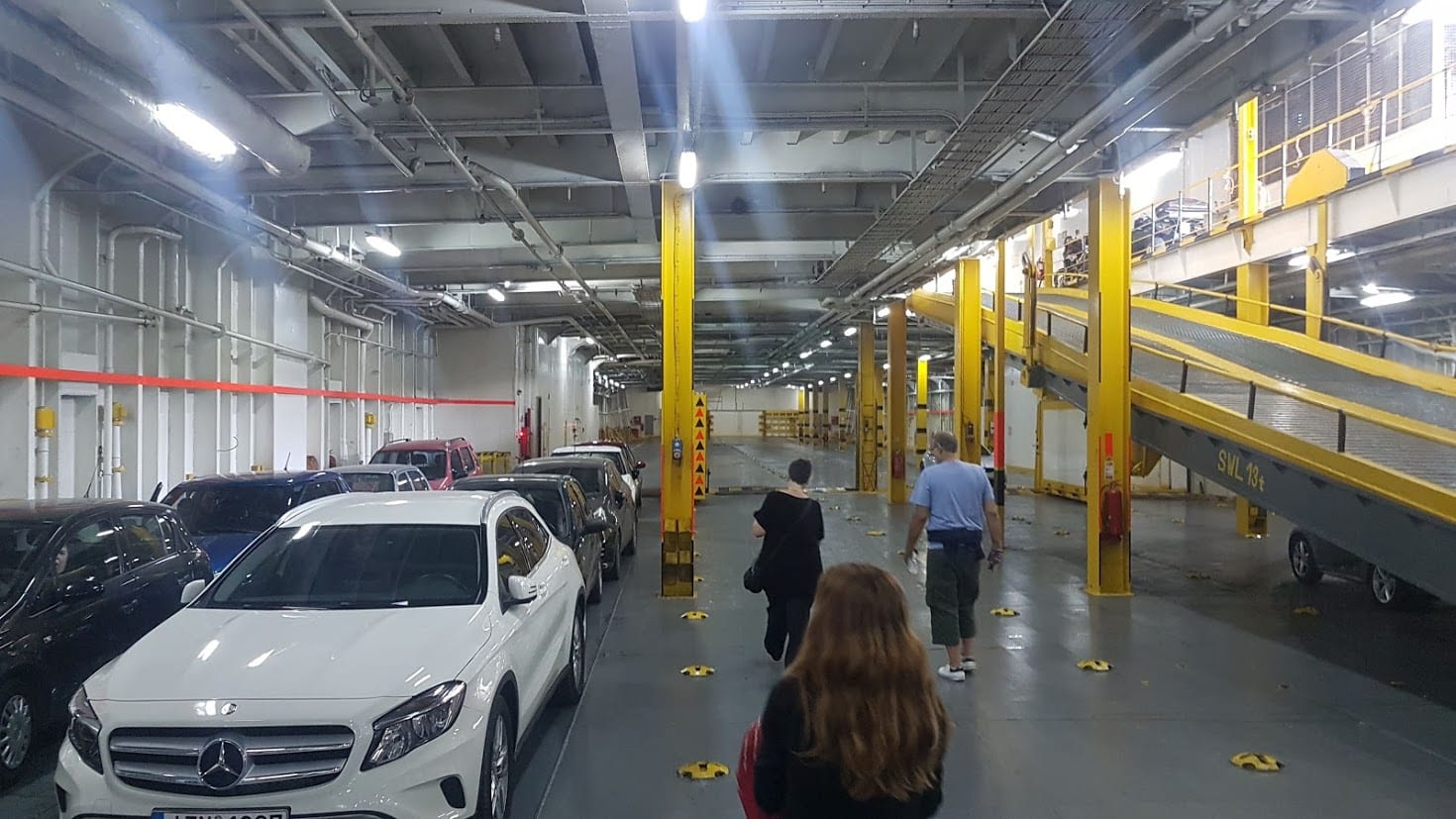
Note that if you are renting a car in Greece, it is not always possible to take it on a ferry. In fact, it’s not a good idea, as it would cost you a lot more. It’s best to rent a car in every island you travel to.
Related: Best time to go to Greece
Greek island ferry companies
If you have been to Greece before, you will know that there are dozens of companies operating in the country. We've included all of them in the list below, and most of the ferries can be booked online.
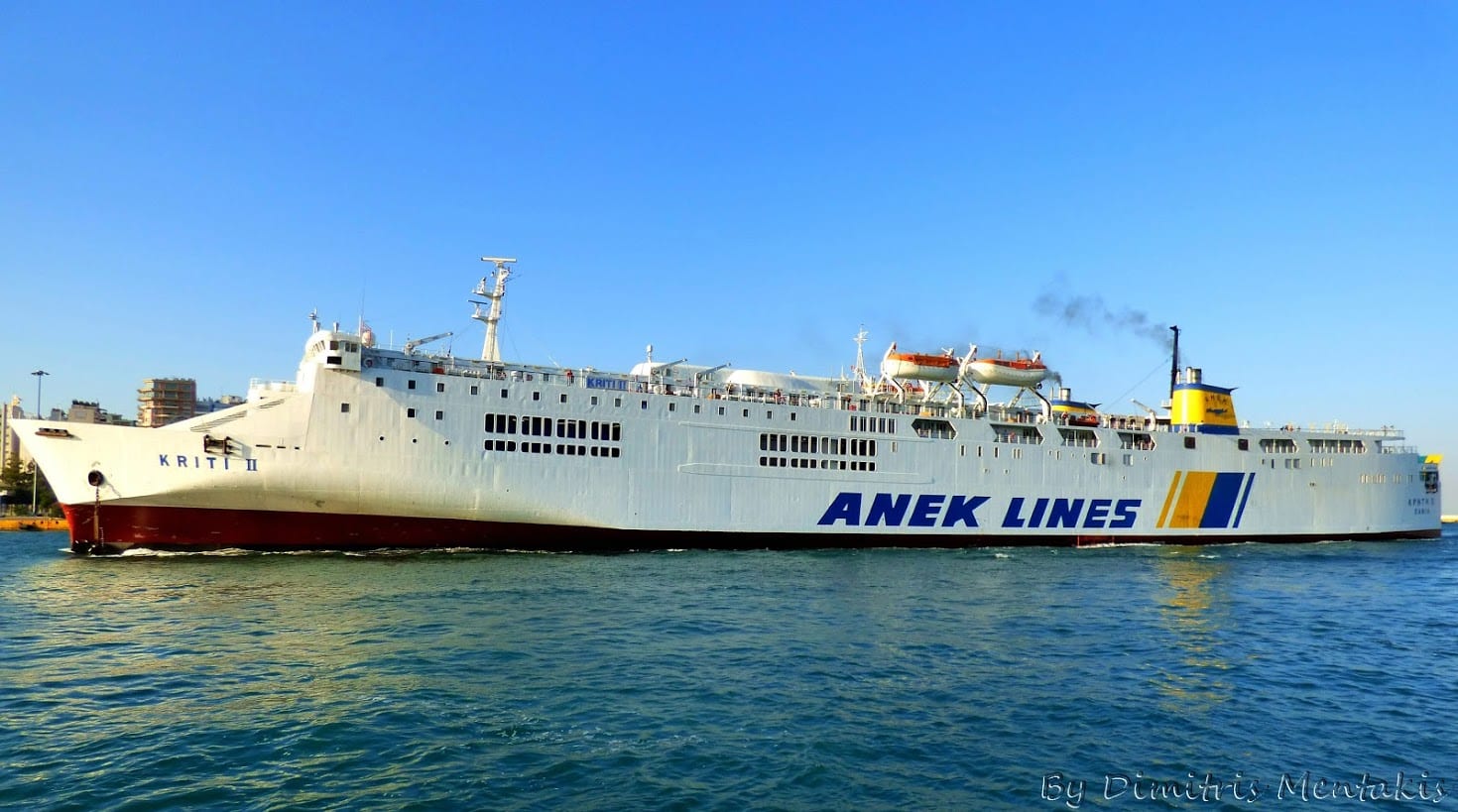
Within each company’s section, you will also find a brief description of the vessels they operate. This will help you decide which one to choose.
As you will see, in most cases we have not included the exact islands that these ferries cover. This is because the routes that the ferries operate on change from year to year.
In fact, sometimes, Greek ferries are sold to other Greek companies. In these cases, they are usually renamed and renovated. Occasionally, they are bought by foreign companies and sent abroad.
List of Greek ferry companies
The main ferry companies in Greece, in no particular order:
1. SeaJets – Athens to the Cyclades and Crete
2. Blue Star Ferries – Athens to the Cyclades and the Dodecanese
3. Hellenic Seaways – Athens to several groups of islands in the Aegean Sea
4. Golden Star Ferries – Athens to the Cyclades
5. Aegean Speed Lines – Ferry to the Cyclades
6. Fast Ferries – Athens to the Cyclades
7. Sea Speed Ferries – Athens to the Cyclades and Crete
8. Zante Ferries – Slow ferries to the Cyclades islands
9. Small Cyclades Lines – Naxos, Amorgos and the Small Cyclades
10. ANEK Lines – The Cyclades, Crete, the Dodecanese and Italy
11. Minoan Lines – Athens to Crete and the Cyclades, Greece – Italy routes
12. Superfast Ferries – Greece to Italy
13. Ventouris Ferries – Greece to Italy
14. Levante Ferries – Ionian islands
15. Kefalonian Lines – Ionian islands
16. Corfu Ferries, Kerkyra Seaways & Kerkyra Lines – Ionian islands, Corfu and Paxi
17. Anes Ferries – Local routes around Greece
18. Skyros Shipping Co – Evia and Sporades
19. Triton / Avlemonas Ferries – Kea and Kythira
20. Goutos Lines – Athens to Kea and Kythnos
21. Saronic ferries – Ferries to the Saronic islands
22. Aegean Flying Dolphins – Ferries to the Saronic islands and the Sporades
23. Panorama – Rafina to Marmari in Evia
24. ANE Kalymnou – Rhodes to Chalki in the Dodecanese
25. Dodekanisos Seaways – Dodecanese islands
26. Alco Ferries – Rhodes to Chalki in the Dodecanese
27. Sea Dreams – Rhodes to Symi and Turkey
28. Lafasi – Kos to Kalymnos and Turkey
29. Other ferries from Greece to Turkey
How to use this Greek ferries guide
If you know which ferry you are planning to travel with, you can hit “Control+F” on your browser. This will bring up a search box, where you can type the name of the ferry. Then you will be taken to a section with some information about it.
If you want to know more about a specific ferry company, you can search for its name in the same way. Alternatively, you can just click the links above.
1. SeaJets – Athens to the Cyclades and Crete
The SeaJets company run 15 highspeed vessels and 2 conventional ferries from Athens to the Cyclades and Crete. These ferries range from smaller boats with no vehicle capacity to a few that are over 100 metres long.
The highspeed SeaJets have no deck option, so you will be indoors for the duration of your trip. They all have different types of reserved seats, while none of them have cabins. Tickets tend to be on the expensive side, but if time is important they are a good option.
We are listing all of the highspeed SeaJet ferries below, starting from the largest one. Most of them are catamarans, which means that they have two parallel hulls, improving their stability. Tera Jet and Paros Jet, the two largest vessels, are monohulls.
1a. Highspeed SeaJets with vehicle capacity
You may not have your own vehicle, so you wouldn’t really care whether the ferry carries vehicles or not. However, the bigger the ferry, the steadier it will generally be when the weather gets windy.
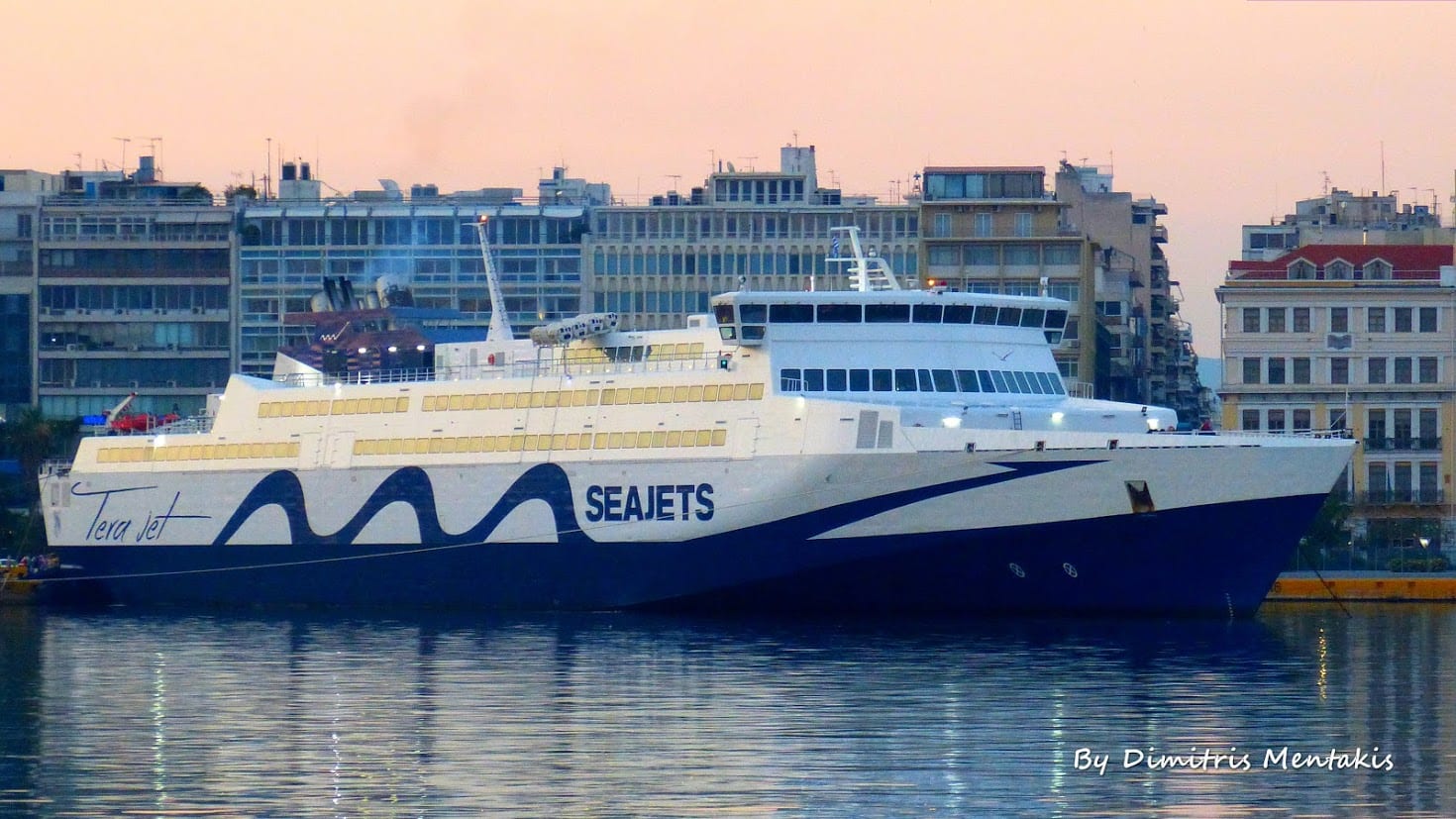
Tera Jet – Monohull
Built: 1999, Italy
Length: 145 metres
Speed: 40 knots
Passenger capacity: 2,000
Vehicle capacity: 500
Paros Jet – Monohull
Built: 1996, Italy
Length: 103 metres
Speed: 37 knots
Passenger capacity: 850
Vehicle capacity: 150
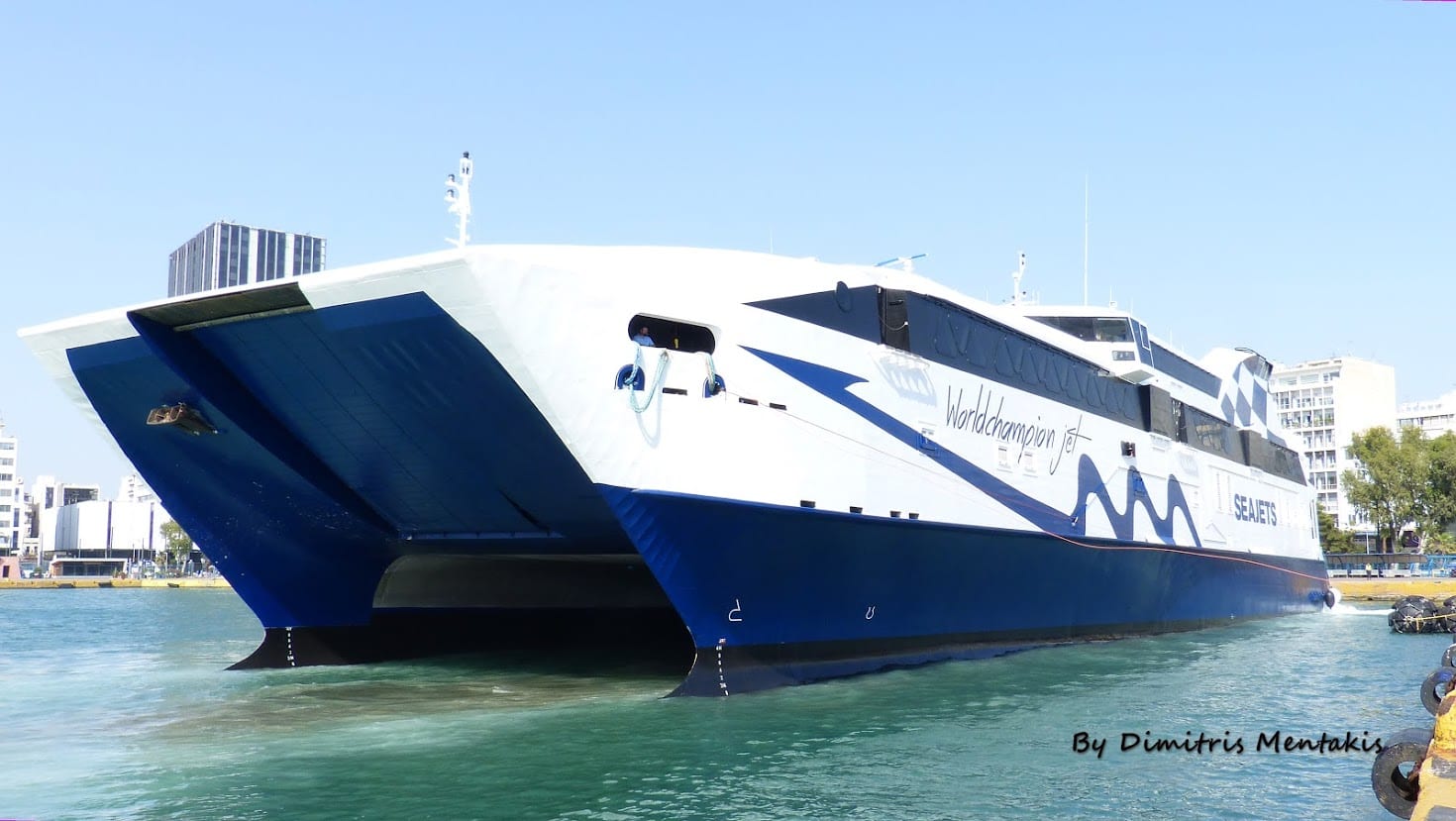
Worldchampion Jet
Built: 2000, Australia
Length: 87 metres
Speed: 50 knots – this is 92 kms / 57.5 miles per hour!
Passenger capacity: 1,310
Vehicle capacity: 222
Champion Jet 1 and Champion Jet 2
Built: 1997, Australia
Length: 87 metres
Speed: 40 knots
Passenger capacity: 1,000
Vehicle capacity: 200
PowerJet
Built: 1996, Australia
Length: 82.30 metres
Speed: 38 knots
Passenger capacity: 800
Vehicle capacity: 150
MegaJet
Built: 1996, Australia
Length: 77.5 metres
Speed: 33 knots
Passenger capacity: 845
Vehicle capacity: 150
HSC CAT
Built: 1990, Australia
Length: 74 metres
Speed: 37 knots
Passenger capacity: 700
Vehicle capacity: 50
High Speed Jet (formerly Speedrunner I)
Built: 1990, Australia
Length: 74 metres
Speed: 37 knots
Passenger capacity: 600
Vehicle capacity: 75
Master Jet, also known as Caldera Vista
Built: 1991, Australia
Length: 74 metres
Speed: 37 knots
Passenger capacity: 700
Vehicle capacity: 85
Naxos Jet
Built: 1991, Australia
Length: 74 metres
Speed: 37 knots
Passenger capacity: 700
Vehicle capacity: 75
Andros Jet
Built: 1997, Australia
Length: 60 metres
Speed: 36 knots
Passenger capacity: 600
Vehicle capacity: 75
1b. Highspeed SeaJets without vehicle capacity
SeaJets also operates three smaller catamarans, that have no vehicle capacity. These ferries are better for shorter trips, as the ride can be a little bumpy. We would prefer to avoid them for longer trips, but they could be ok for shorter trips between the islands.
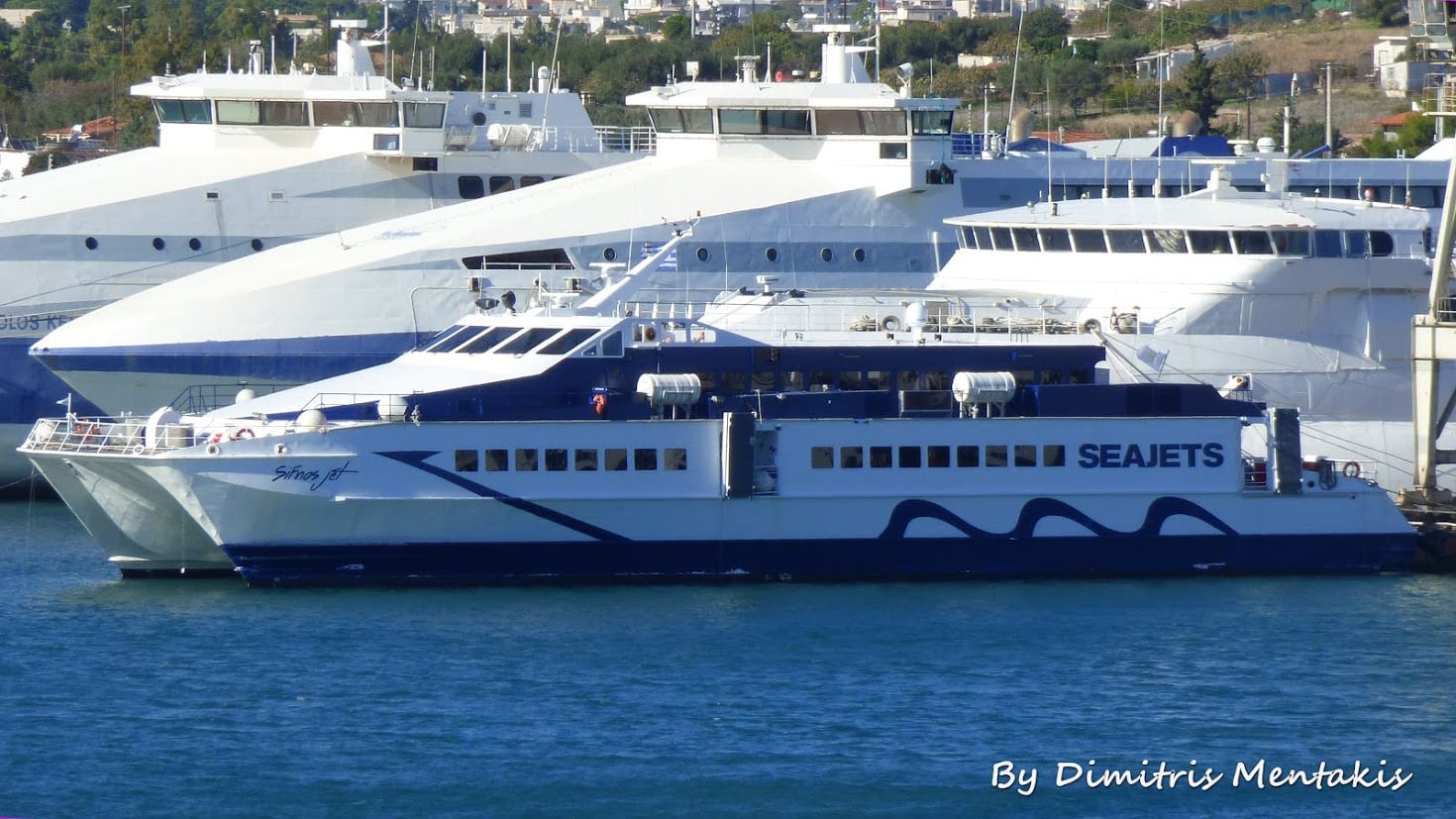
Sifnos Jet
Built: 1999, Australia
Length: 52.4 metres
Speed: 38 knots
Passenger capacity: 500
SuperJet
Built: 1995, Finland
Length: 42 metres
Speed: 38 knots
Passenger capacity: 394
SeaJet 2
Built: 1998, Norway
Length: 42 metres
Speed: 38 knots
Passenger capacity: 386
1c. Conventional ferries run by the SeaJets company
SeaJets also operates two conventional ferries, that are ideal for people looking for budget options. These ferries also have cabins. If you are not in a hurry, you will enjoy your trip on these ferries.
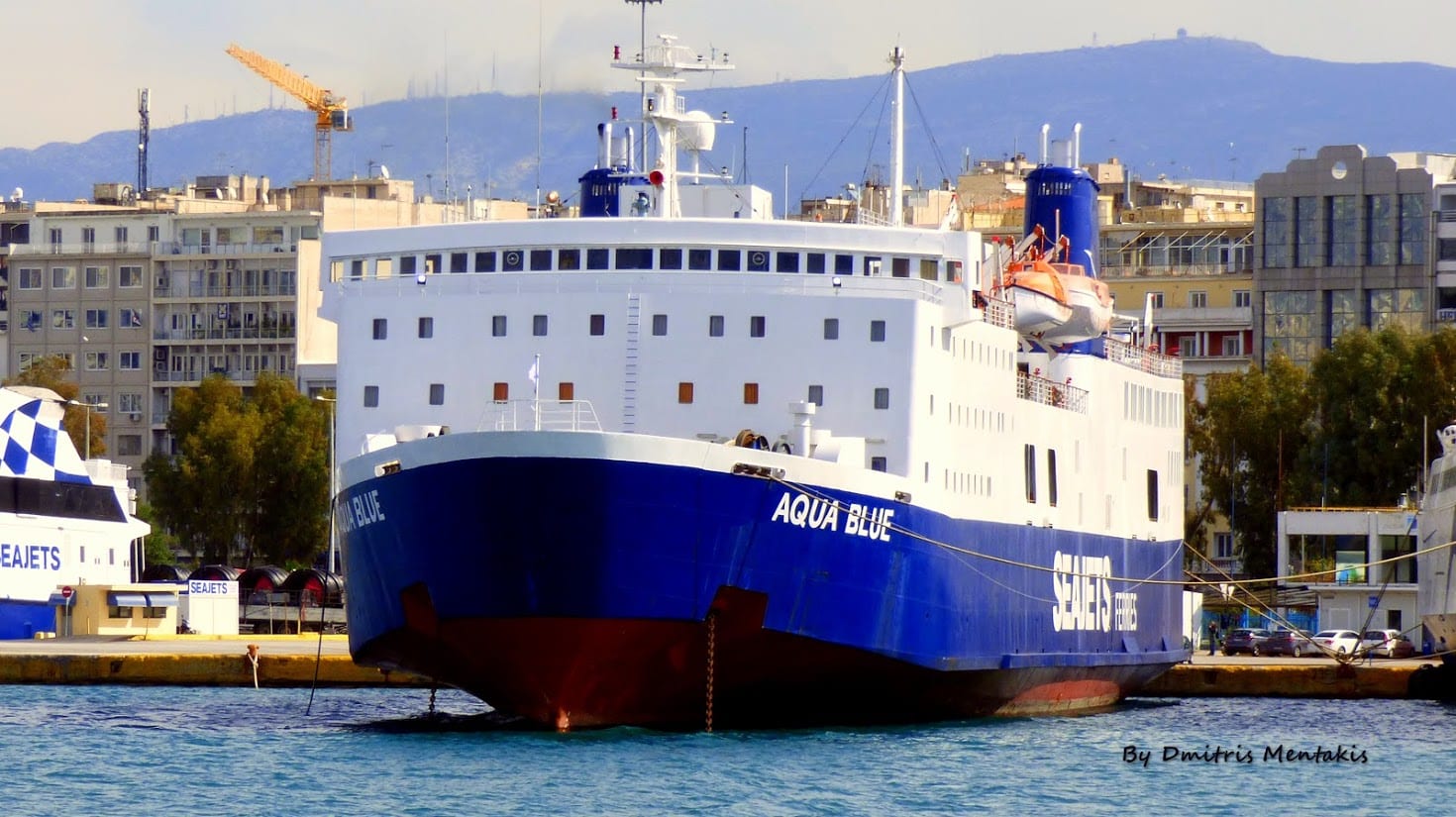
Aqua Blue
Built: 1975, Japan, refurbished in 1995 and 2016.
Length: 127.6 metres
Speed: 23 knots
Passenger capacity: 1300
Vehicle capacity: 400
We have actually travelled on this ferry a few times, even during very windy weather, and were quite happy with it. It used to belong to different companies in the past, and has been renamed a couple of times.
Aqua Jewel
Built: 2002, Greece
Length: 108 metres
Speed: 20 knots
Passenger capacity: 661
Vehicle capacity: 160
For more information and photos of these highspeed ferries, you can check out the SeaJets website.
2. Blue Star Ferries – Athens to the Cyclades and the Dodecanese
Blue Star Ferries are one of the most popular and well-known companies in Greece. They operate several large passenger / car ferries in the Aegean. They are part of the Attica Group of ferries, alongside Hellenic Seaways and Superfast Ferries.
All of these ferries are big, conventional ferries, with plenty of deck space, cabins and large garages. There are many cafes and restaurants on board, and you can walk around most areas.
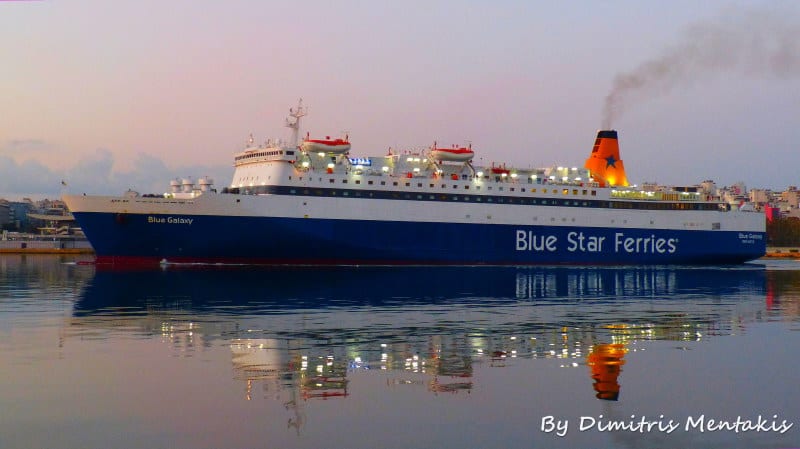
Blue Galaxy
Built: 1992, Japan
Length: 192 metres
Speed: 24 knots
Passenger capacity: 1,790
Vehicle capacity: 780
Cabins: 176
Blue Horizon
Built: 1987, Japan
Length: 187.1 metres
Speed: 24.5 knots
Passenger capacity: 1,488
Vehicle capacity: 780
Cabins: 164
Blue Star 1
Built: 2000, Netherlands
Length: 176.1 metres
Speed: 28 knots
Passenger capacity: 1,890
Vehicle capacity: 780
Cabins: 192
Blue Star 2
Built: 2000, Netherlands
Length: 176.1 metres
Speed: 28 knots
Passenger capacity: 1,854
Vehicle capacity: 780
Cabins: 176
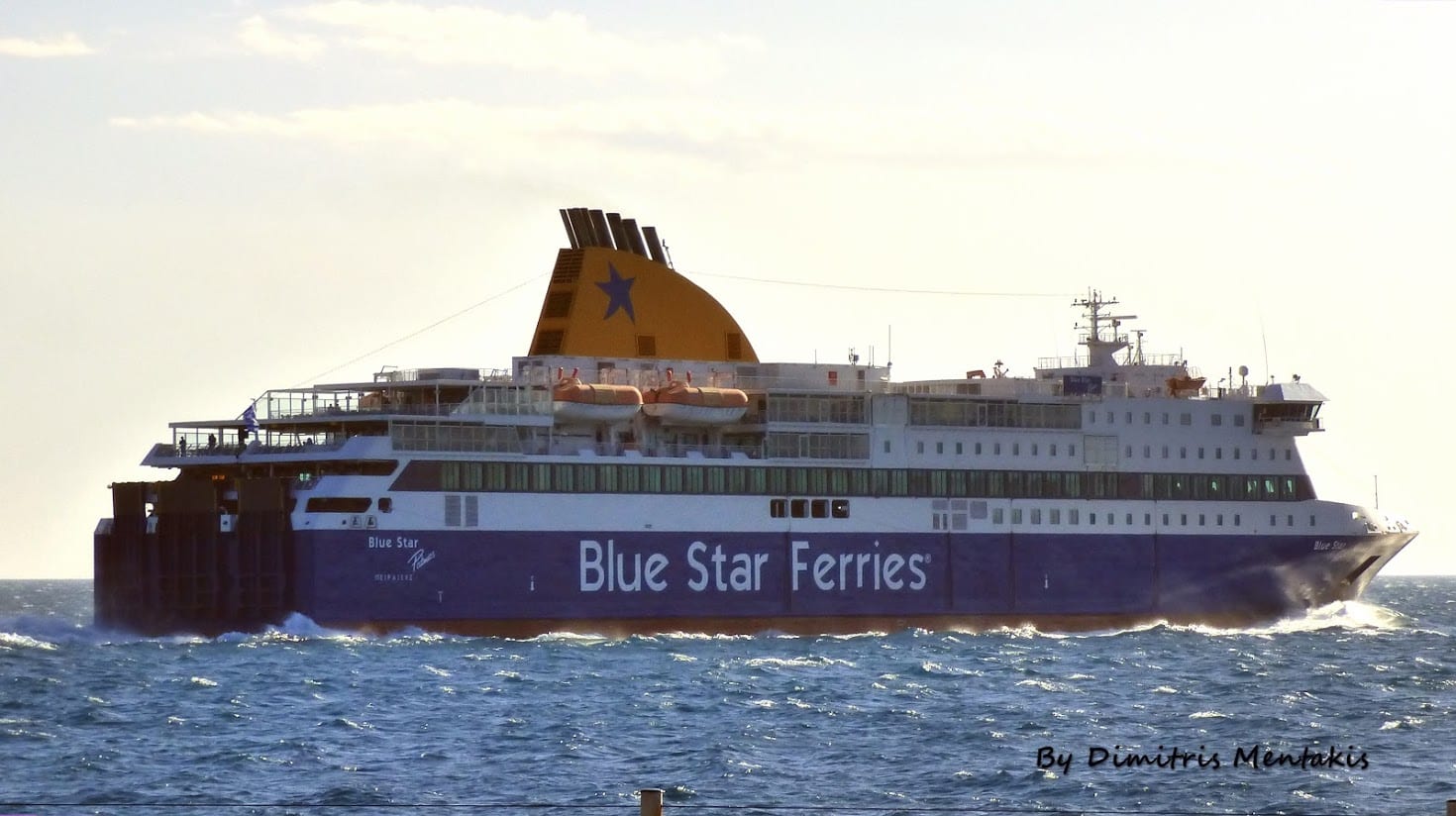
Blue Star Patmos
Built: 2012, South Korea
Length: 145.9 metres
Speed: 25.5 knots
Passenger capacity: 2,000
Vehicle capacity: 430
Cabins: 90
Blue Star Delos
Built: 2011, South Korea
Length: 145.9 metres
Speed: 25.5 knots
Passenger capacity: 2,400
Vehicle capacity: 430
Cabins: 32
Diagoras
Built: 1989, Japan
Length: 141.5 metres
Speed: 21.1 knots
Passenger capacity: 1,462
Vehicle capacity: 274
Cabins: 131
Blue Star Chios (formerly Nissos Chios)
Built: 2007, Greece
Length: 141 metres
Speed: 27 knots
Passenger capacity: summer 1,782, winter 1,213
Vehicle capacity: 418
Cabins: 72
Blue Star Mykonos (formerly Nissos Mykonos)
Built: 2005, Greece
Length: 141 metres
Speed: 26.5 knots
Passenger capacity: summer 1,915, winter 1,274
Vehicle capacity: 418
Cabins: 29
Blue Star Paros and Blue Star Naxos
Built: 2002, South Korea
Length: 124.2 metres
Speed: 24.4 knots
Passenger capacity: 1,474
Vehicle capacity: 240
Cabins: 26
More here: Bluestar Ferries
3. Hellenic Seaways – Athens to several groups of islands in the Aegean Sea
Like Blue Star Ferries, Hellenic Seaways is operated under the umbrella company called Attica Group. They run four types of ferries, travelling all around the Aegean.
For 2020, they travel to the Cyclades, the Sporades, the Argosaronic islands, Northeastern Aegean islands, Crete and the Dodecanese. Their ferries differ a lot between them, ranging from large conventional ferries to small vessels.
3a. Hellenic Seaways – Conventional ferries
This is a range of moderately priced ferries for visitors who like to take their time. They run on different routes around Greece. Facilities vary widely, as do seating arrangements and cabin options.

Ariadne
Built: 1995, Japan
Length: 195.95 metres
Speed: 24 knots
Passenger capacity: 2,045
Vehicle capacity: 640
Cabins: 145
Nissos Samos
Built: 1988, Japan
Length: 192.9 metres
Speed: 20.5 knots
Passenger capacity: summer 2,202, winter 1,578
Vehicle capacity: 730
Cabins: 108
Nissos Rodos
Built: 1987, Japan
Length: 192.5 metres
Speed: 22 knots
Passenger capacity: summer 2,210, winter 1,683
Vehicle capacity: 748
Cabins: 98
Express Pegasus
Built: 1977, Italy
Length: 125.7 metres
Speed: 19 knots
Passenger capacity: summer 1,294, winter 1,092
Vehicle capacity: 185
Cabins: 8
Artemis
Built: 1997, Greece
Length: 89.8 metres
Speed: 19.2 knots
Passenger capacity: summer 748, winter 590
Vehicle capacity: 65
Express Skiathos
Built: 1996, Greece
Length: 77.9 metres
Speed: 18.5 knots
Passenger capacity: summer 1,013, winter 695
Vehicle capacity: 175
3b. Hellenic Seaways – Highspeed ferries
These vessels are much faster than the conventional ones. Like other high-speed ferries, they have no deck or cabin options.

Hellenic Highspeed – Monohull
Built: 1996, Italy
Length: 100 metres
Speed: 34 knots
Passenger capacity: 724
Vehicle capacity: 175
Highspeed 4 – Catamaran
Built: 2000, Australia
Length: 92.4 metres
Speed: 38 knots
Passenger capacity: 1,010
Vehicle capacity: 188
3c. Hellenic Seaways – Flying Cats
The company operates four catamaran vessels in this category. They are called Flying Cat 3, 4, 5 and 6, which some people would think is slightly unimaginative.
All these vessels are fairly small, and have no deck options, cabins or vehicle capacity. We would prefer to avoid them on a long trip, as it could end up being a bumpy ride. If you like walking around ferries and enjoying the deck, or if you get seasick easily, you might prefer to avoid them as well.
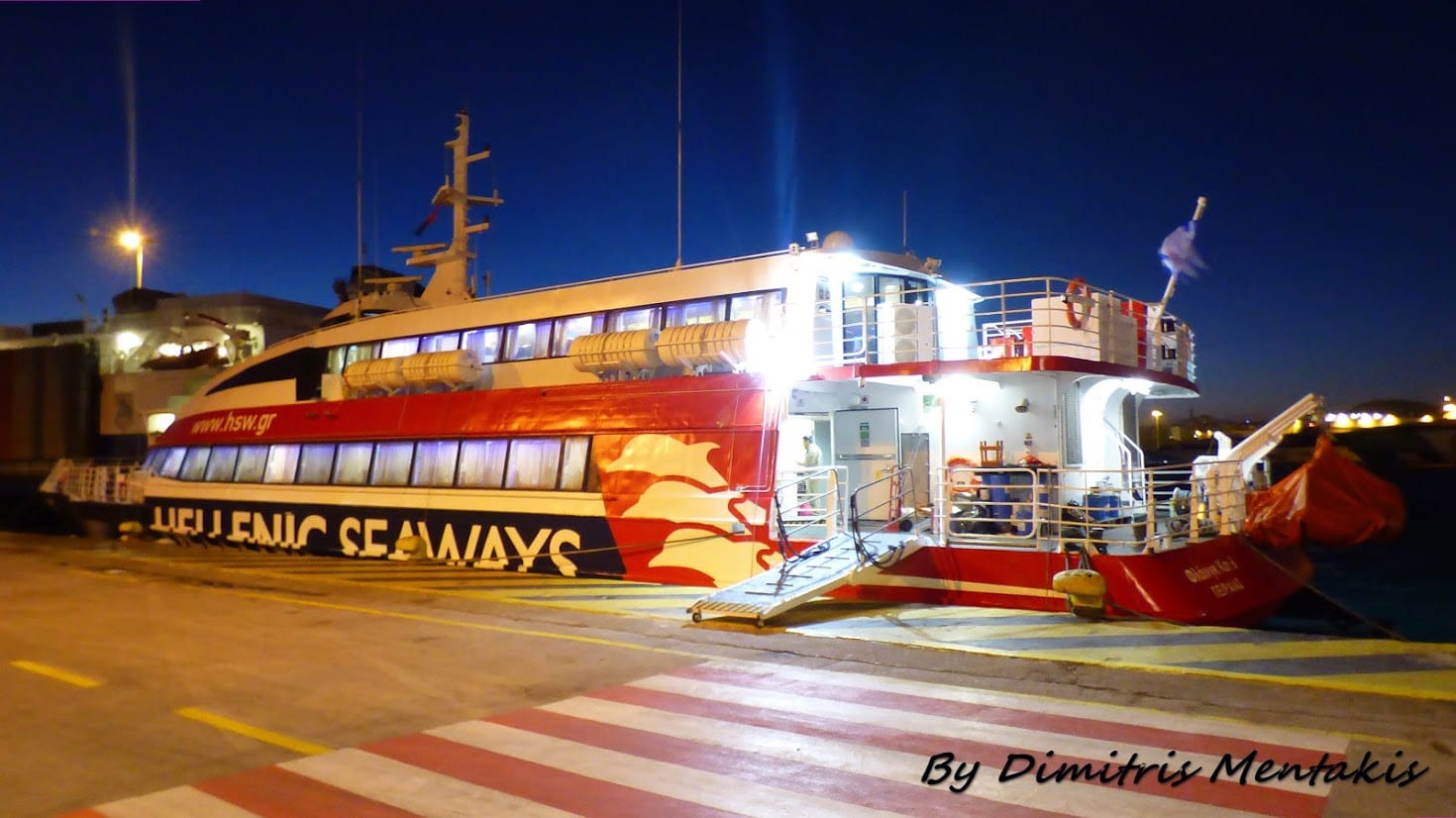
Flying Cat 4
Built: 1999, England
Length: 55.1 metres
Speed: 42 knots
Passenger capacity: 438
Flying Cat 3
Built: 1997, England
Length: 47.7 metres
Speed: 42 knots
Passenger capacity: 342
Flying Cat 5
Built: 1996, Norway
Length: 40 metres
Speed: 28 knots
Passenger capacity: 336
Flying Cat 6
Built: 1997, Singapore
Length: 40 metres
Speed: 28 knots
Passenger capacity: 336
3d. Hellenic Seaways – Flying Dolphins
These are some of the smallest passenger catamarans in the Aegean, named Flying Dolphin 17 and 29. Who knows how many they were to begin with!
In our experience, they are not super pleasant to travel on when the seas are rough, but this may be your only option. Your trip is unlikely to be very long, so you should be fine.

Flying Dolphin 17
Built: 1984, Russia
Length: 34.50 metres
Speed: 35 knots
Passenger capacity: 130
Flying Dolphin 29
Built: 1991, Russia
Length: 34.25 metres
Speed: 35 knots
Passenger capacity: 130
For more information: Hellenic Seaways
4. Golden Star Ferries – Athens to the Cyclades
Golden Star Ferries currently operate two conventional ferries, one of which has cabins. They also have four high-speed ferries, two of which can carry vehicles.
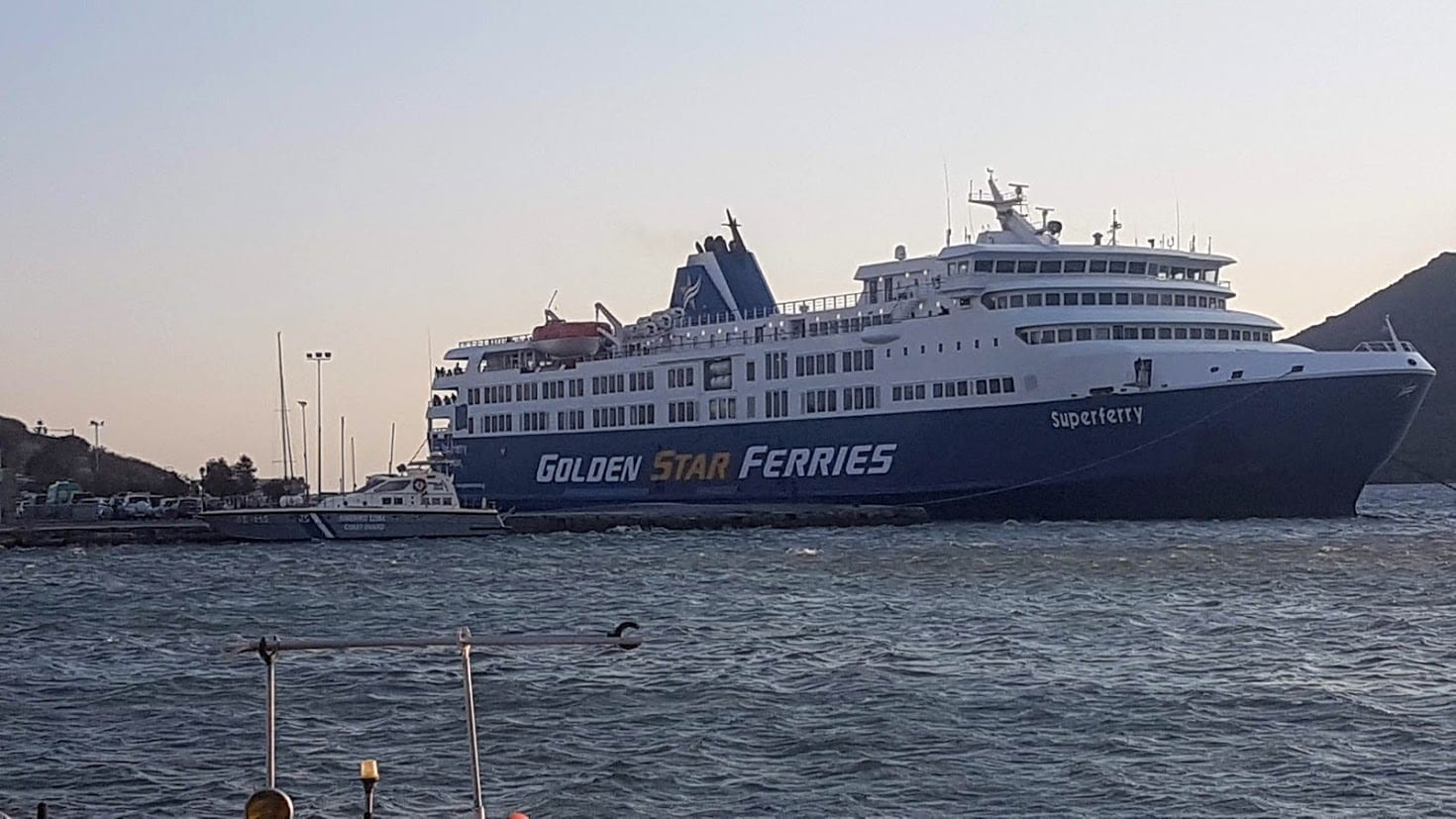
Superferry II
Built: 1974, Belgium
Length: 121.7 metres
Speed: 21 knots
Passenger capacity: 1,630
Vehicle capacity: 250
Cabins: Yes
Superferry
Built: 1995, Japan
Length: 121 metres
Speed: 21 knots
Passenger capacity: 1,760
Vehicle capacity: 280
Superrunner (formerly Speedrunner IV)
Built: 1999, Italy
Length: 100.4 metres
Speed: 33 knots
Passenger capacity: 810
Vehicle capacity: 180
Superexpress
Built: 1998
Length: 91 metres
Speed: 35 knots
Passenger capacity: 1,070
Vehicle capacity: 200
Superspeed
Built: 2002
Length: 54.5 metres
Speed: 33 knots
Passenger capacity: 400
Supercat
Built: 2000
Length: 45.36 metres
Speed: 35 knots
Passenger capacity: 400
For more information on the Golden Star Ferries, visit their website.
5. Aegean Speed Lines – Ferry to the Cyclades
Aegean Speed Lines operate a large high-speed ferry, Speedrunner III, to the Cyclades. There is a range of seating arrangements, and no cabins.
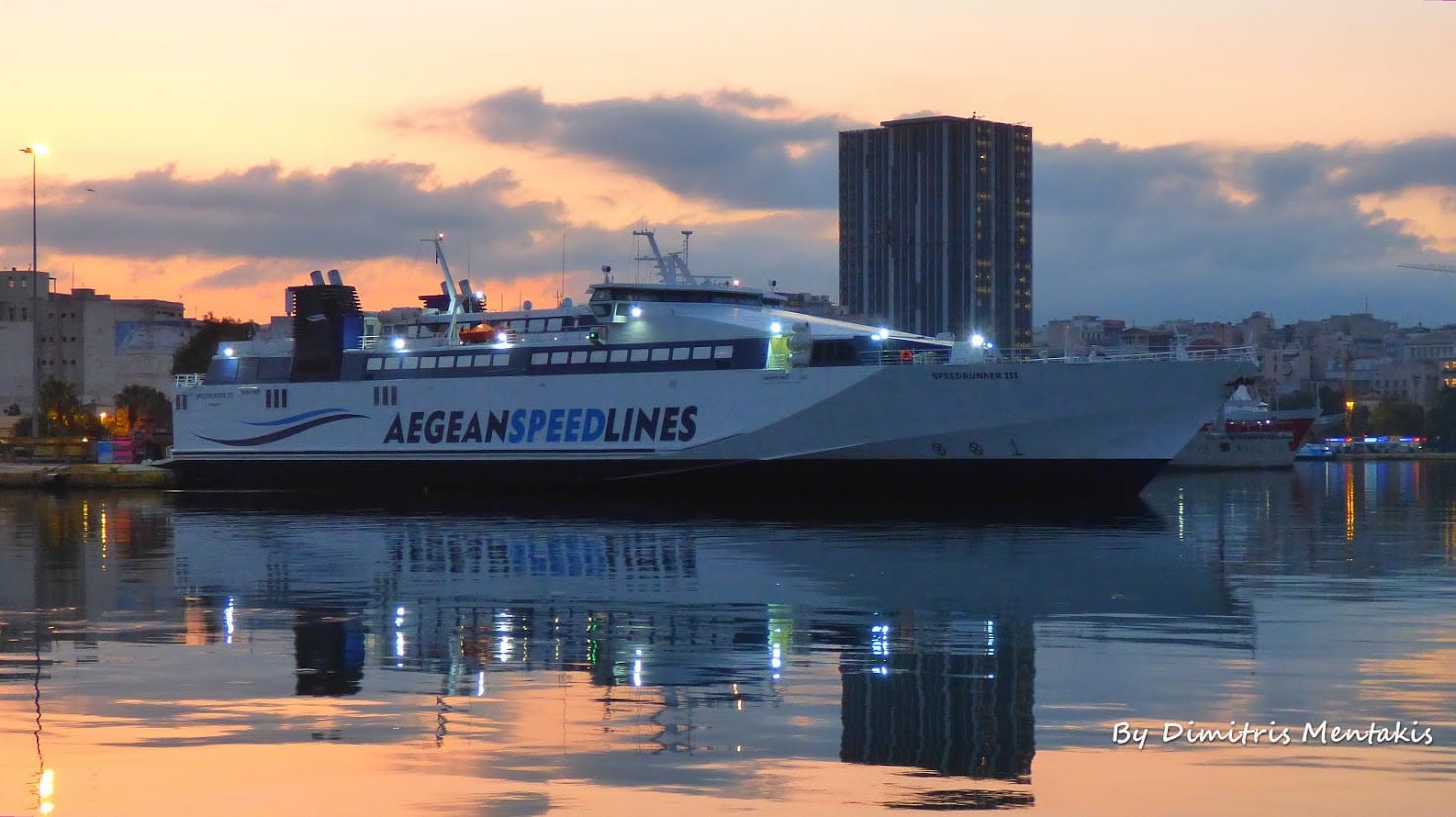
Speedrunner III
Built: 1999, Italy
Length: 100.4 metres
Speed: 34 knots
Passenger capacity: 800
Vehicle capacity: 170
You can find more information about the Speedrunner III here.
6. Fast Ferries – Athens to the Cyclades
Fast Ferries are a smaller company running a total four ferries. They are currently collaborating with Minoan lines on certain routes.
In 2023, they are running a highspeed vessel called Thunder, which connects Piraeus, certain Cyclades islands and Heraklion in Crete.
Thunder
Built: 1998, Australia
Length: 86.6 metres
Speed: 38 knots
Passenger capacity: 1,068
Vehicle capacity: 210
Fast Ferries also run three conventional ferries to the Cyclades. There are no cabin options, but there is availability for vehicles. They are a great budget option.
You will easily spot these photogenic ferries departing from Rafina port, as they are all bright red.

Ekaterini P.
Built: 1990, Japan
Length: 121.5 metres
Speed: 21 knots
Passenger capacity: 1,127
Vehicle capacity: 240
Theologos P.
Built: 2000, Japan
Length: 118.1 metres
Speed: 22 knots
Passenger capacity: 1,154
Vehicle capacity: 300
Fast Ferries Andros
Built: 1989, Japan
Length: 115 metres
Speed: 19.5 knots
Passenger capacity: 1,200
Vehicle capacity: 280
Check them out here.
7. Sea Speed Ferries – Athens to the Cyclades and Crete
Sea Speed Ferries currently operate one conventional passenger / car ferry called Olympus. It’s a reasonably priced alternative to some faster ferries.
For 2020, this ferry connects Milos, Santorini and Rethymno in Crete a few times per week.

Olympus
Built: 1976, Japan
Length: 141.7 metres
Speed: 16.5 knots
Passenger capacity: 1,000
Vehicle capacity: 450
Cabins: Yes
8. Zante Ferries – Slow ferries to the Cyclades islands
You would have thought that Zante Ferries travel to the Ionian islands, but no. These two slow ferries connect several of the lesser visited Cyclades islands, including Kimolos, Sikinos and Folegandros.
They are a great budget option for people who are not in a hurry. We can’t wait to use them this summer!
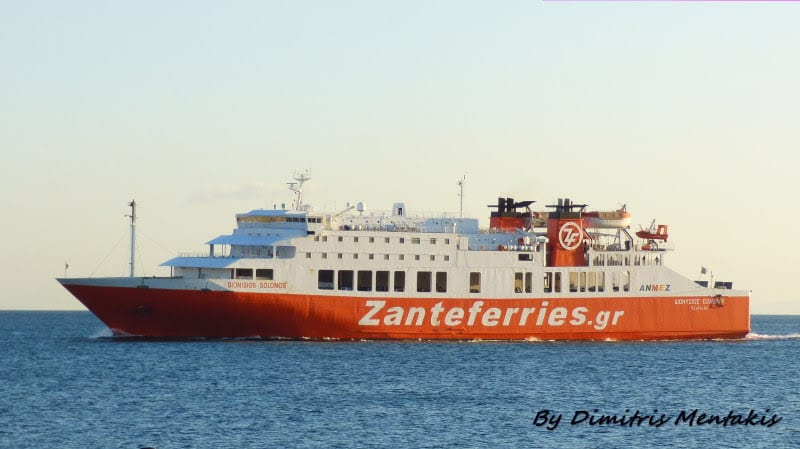
Dionysios Solomos
Built: 1987, refurbished in 2012
Length: 121.5 metres
Speed: 19.5 knots
Passenger capacity: 1,030
Vehicle capacity: 300
Number of beds: 40
Adamantios Korais
Built: 1987
Length: 100 metres
Speed: 18.3 knots
Passenger capacity: 1,100
Vehicle capacity: 390
Number of beds: 44
The company is also supposed to launch a ferry connecting Alexandroupolis port with the island of Samothraki. This ferry is called Proteas, currently operating by Anes ferries. Watch this space!
9. Small Cyclades Lines – Naxos, Amorgos and the Small Cyclades
This family company operates one of the most iconic ferries in the Aegean, Express Skopelitis. This small ferry connects Naxos with Amorgos and the Small Cyclades – Iraklia, Schinoussa, Koufonissi and Donoussa.
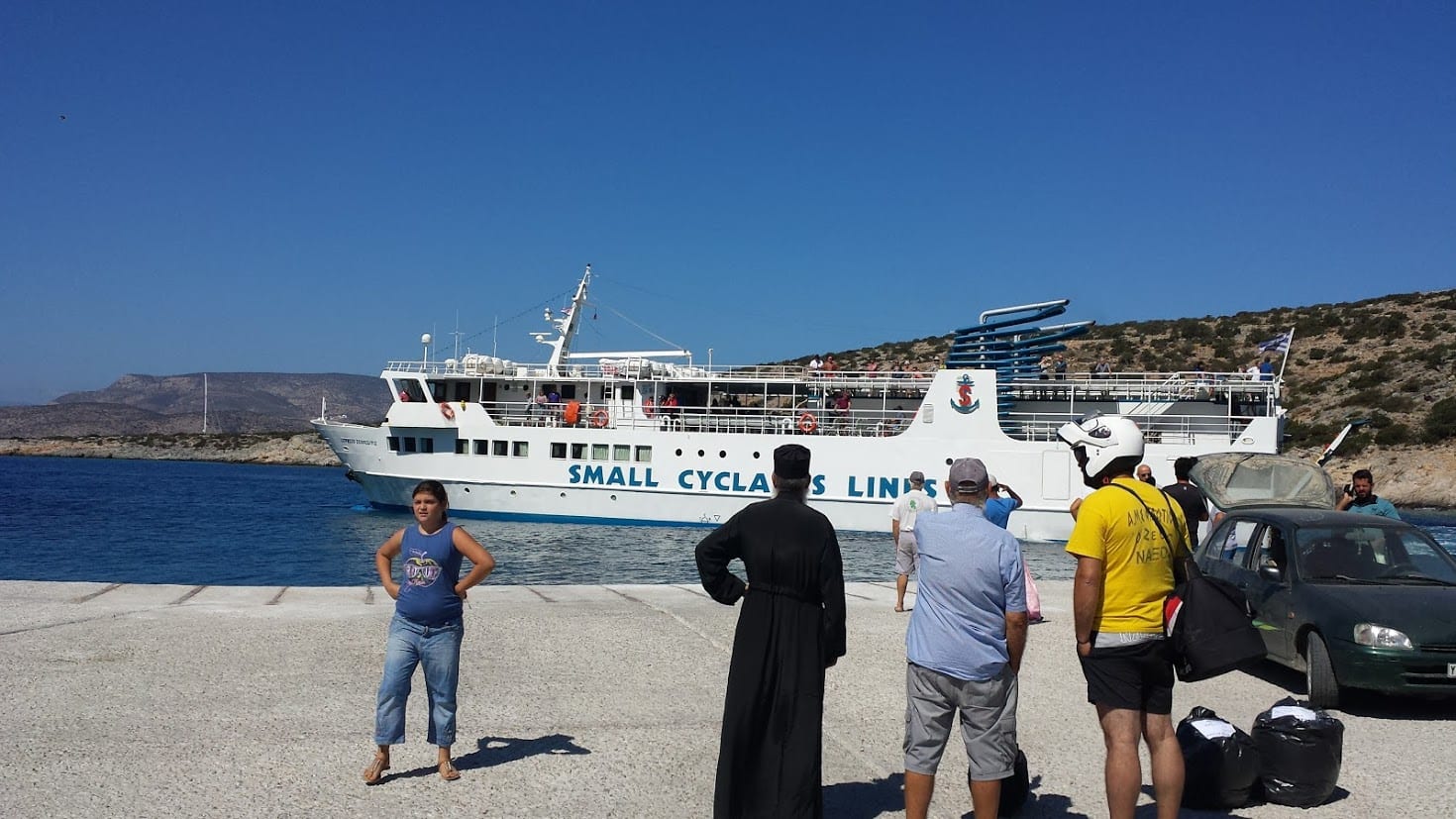
It’s a basic little ferry, providing invaluable service for these off-the-beaten-track islands. For summer 2020, It also goes to Santorini and Ios once a week.
Express Skopelitis
Built: 1986
Length: 45 metres
Speed: 12.3 knots
Passenger capacity: 340
Vehicle capacity: 11
10. ANEK Lines – The Cyclades, Crete, the Dodecanese and Italy
ANEK Lines operate some of the largest ferries in Greece. Their destinations include Crete and the Dodecanese. Some of their ferries go to Italy, connecting Patras, Igoumenitsa and Corfu with the Italian ports.
All their ferries are pretty massive, and they have capacity for many hundreds of visitors and vehicles. Some of them serve very long routes, and travelling on them can be quite an experience.
These are the ANEK ferries currently running in Greece.
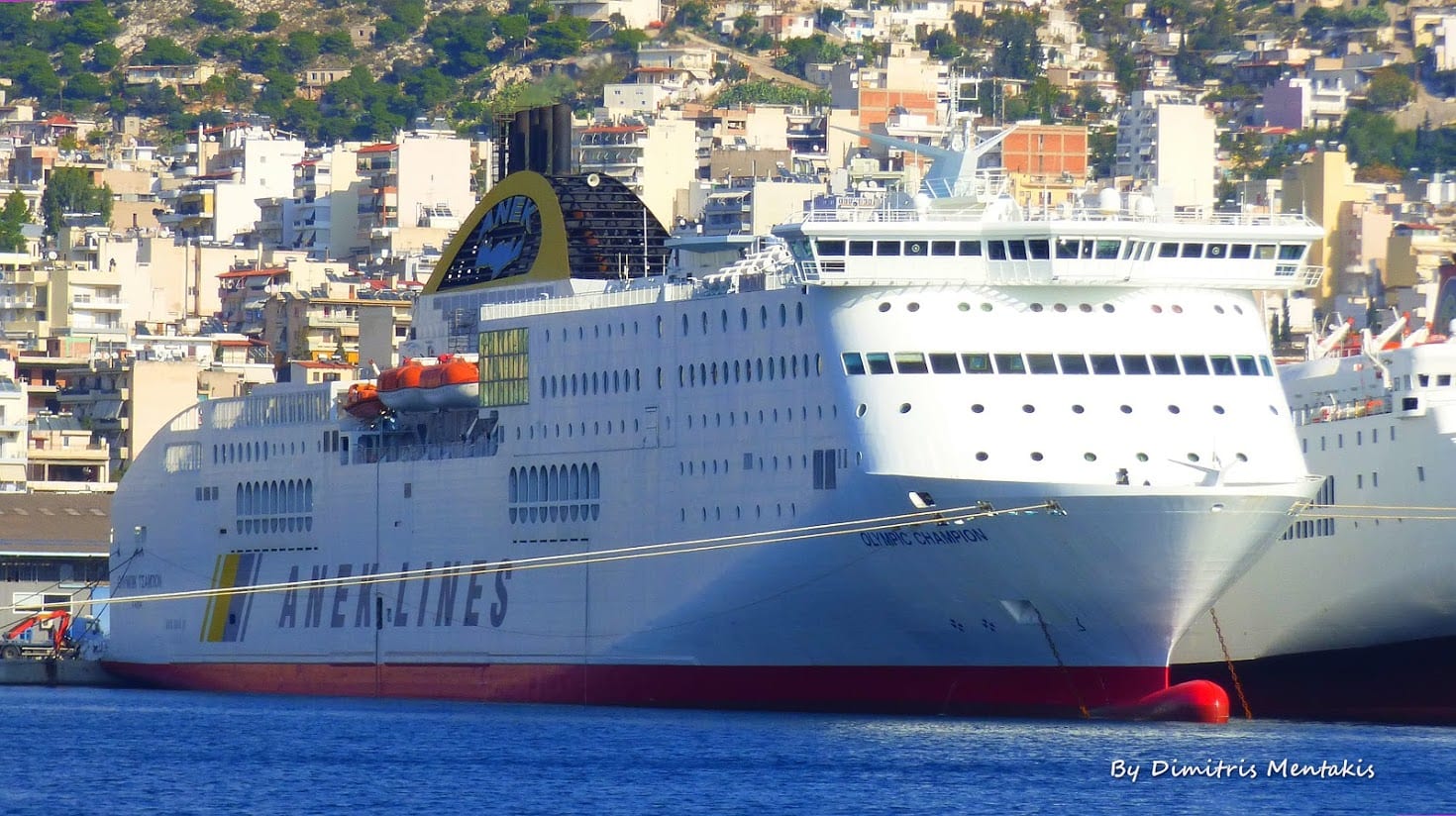
Olympic Champion
Built: 2000, Norway
Length: 204 metres
Speed: 30 knots
Passenger capacity: 1,833
Vehicle capacity: 670
Number of beds: 808
Hellenic Spirit
Built: 2001, Norway
Length: 204 metres
Speed: 30 knots
Passenger capacity: 1,850
Vehicle capacity: 670
Number of beds: 710
Asterion II (also known as Grand Spring)
Built: 1991, Japan
Length: 192.5 metres
Speed: 22 knots
Passenger capacity: 1,020
Vehicle capacity: 840
Number of beds: 451
Elyros
Built: 1998, Japan
Length: 192 metres
Speed: 24 knots
Passenger capacity: 1,874
Vehicle capacity: 620
Number of beds: 776
Kriti II
Built: 1979, Japan
Length: 192 metres
Speed: 23 knots
Passenger capacity: 1,500
Vehicle capacity: 719
Number of beds: 468
Kriti I
Built: 1979, Japan
Length: 192 metres
Speed: 22 knots
Passenger capacity: 1,500
Vehicle capacity: 650
Number of beds: 468
El. Venizelos
Built: 1992, Poland
Length: 175.5 metres
Speed: 21 knots
Passenger capacity: 2,500
Vehicle capacity: 850
Number of beds: 1,606
Prevelis (ANEK / Aegeon Pelagos)
Built: 1980, Japan
Length: 142.5 metres
Speed: 19 knots
Passenger capacity: 927
Vehicle capacity: 310
Number of beds: 251
For more information, check out their website.
11. Minoan Lines – Athens to Crete and the Cyclades, Greece – Italy routes
Minoan Lines operate some of the most luxurious ferries in Greece. They also serve some Greece – Italy routes, connecting Patras, Igoumenitsa and Corfu with Venice and Ancona.
Within Greece, Minoan Lines travel to many of the Cyclades, and also Heraklion and Chania in Crete. They have three large, conventional ferries, and a faster catamaran.

The bigger ferries are the most luxurious we have been on. There is plenty of space, and there are several cafes, restaurants and bars on board.
There are several seat options, as well as a range of cabins. On-board you can also find stores where you can buy a range of items, like souvenirs, clothes, cosmetics and books.
Cruise Europa
Built: 2009, Italy
Length: 225 metres
Speed: 27.5 knots
Passenger capacity: 2,850
Vehicle capacity: 963
Number of beds: 1,257
Cruise Olympia
Built: 2010, Italy
Length: 225 metres
Speed: 27.5 knots
Passenger capacity: 2,850
Vehicle capacity: 963
Number of beds: 1,257
Festos Palace
Built: 2002, Italy
Length: 214 metres
Speed: 31.5 knots
Passenger capacity: 2,184 in summer / 1,865 in winter
Vehicle capacity: 821
Number of beds: 744
Knossos Palace
Built: 2000, Italy
Length: 214 metres
Speed: 31.5 knots
Passenger capacity: 2,500 in summer / 2,448 in winter
Vehicle capacity: 700
Number of beds: 758
Kydon Palace
Built: 2001, Italy
Length: 214 metres
Speed: 31.5 knots
Passenger capacity: 2,500 in summer / 2,448 in winter
Vehicle capacity: 700
Number of beds: 758
The Santorini Palace is a faster catamaran with no cabin or deck options. There are different types of seats you can choose from.
Santorini Palace / Catamaran
Built: 2005, Australia, refurbished in 2016
Length: 85 metres
Speed: 38 knots
Passenger capacity: 1,160
Vehicle capacity: 117
For more information on these ferries, you can check the Minoan Lines website.
Look also at How to get from Athens to Crete
12. Superfast Ferries – Greece to Italy
Superfast Ferries are part of the Attica Group of ferries, alongside Hellenic Seaways and Blue Star Ferries. They connect Greece and Italy, and their Greek ports of call are Patras, Igoumenitsa and Corfu.
Superfast Ferries are currently running three large ferries with capacity for many hundreds of visitors and vehicles.

Superfast I
Built: 2008, Italy
Length: 199 metres
Speed: 24.2 knots
Passenger capacity: 938
Vehicle capacity: 170
Number of cabins: 102
Superfast II
Built: 2009, Italy
Length: 199 metres
Speed: 24.2 knots
Passenger capacity: 938
Vehicle capacity: 170
Number of cabins: 102
Superfast XI
Built: 2002, Germany
Length: 200 metres
Speed: 29 knots
Passenger capacity: 1,821
Vehicle capacity: 900
Number of cabins: 198
13. Ventouris Ferries – Greece to Italy
Ventouris Ferries operate a few large ferries between Greece, Italy and Albania. For 2020, their ferries Rigel I and Rigel VII will run the route Patras – Igoumenitsa on their way to Bari in Italy.
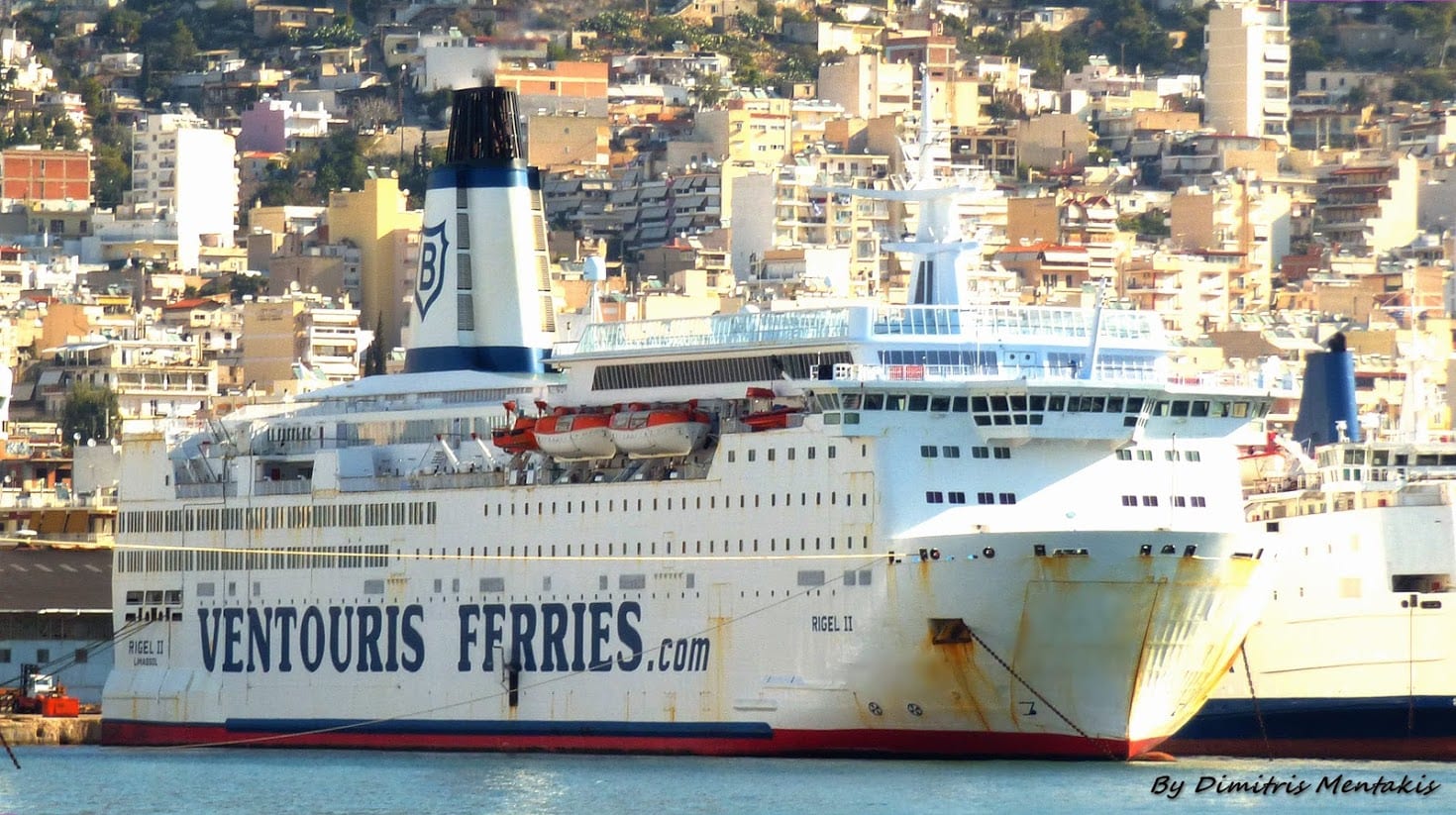
Rigel VII
Built: 1994, Japan
Length: 163.5 metres
Speed: 22.5 knots
Passenger capacity: 775
Vehicle capacity: Yes
Cabins: Yes
Rigel I
Built: 1973
Length: 122 metres
Speed: 19 knots
Passenger capacity: 1,120
Vehicle capacity: 330
Number of beds: 550
14. Levante Ferries – Ionian islands
Levante Ferries currently operate four bright yellow ferries among the ports of Patras, Kyllini and the Ionian islands. Some of them have recently been bought from other shipping companies, and refurbished.
These ferries have no cabins, and they all have vehicle capacity. Interestingly, Fior di Levante can run on electric power.

Kefalonia (formerly known as Nisos Kefalonia)
Built: 1975, Japan. Refurbished in 2019
Length: 120.8 metres
Speed: 21 knots
Passenger capacity: 1,134
Vehicle capacity: 324
Mare di Levante
Built: 1984, Japan
Length: 120.2 metres
Speed: 19 knots
Passenger capacity: 1,068
Vehicle capacity: 350
Fior di Levante
Built: 1998
Length: 118.8 metres
Speed: 19 knots
Passenger capacity: 1,140
Vehicle capacity: 300
Andreas Kalvos
Built: 1985, refurbished in 2019
Length: 98.6 metres
Speed: 17.5 knots
Passenger and vehicle ferry
This is their website.
15. Kefalonian Lines – Ionian islands
This small company is due to operate one ferry for summer 2020. Alexandra L will connect Patras, Killini and the Ionian islands.
Alexandra L (formerly known as Mirtidiotissa)
Built: 1975, Japan
Length: 101.25 metres
Speed: 19 knots
Passenger capacity: 750 summer, 604 winter
Vehicle capacity: 240
16. Corfu Ferries, Kerkyra Seaways & Kerkyra Lines – Igoumenitsa > Corfu > Paxi
These companies are running several routes a day between Igoumenitsa port in mainland Greece, Corfu (known in Greek as Kerkyra) and the small island of Paxi, also known or Paxos.
Guide here: How to get to Paxos island in Greece
At time of writing, the status of the companies is a little unclear, and they seem to be merging up. Here is a list of all the small ferries running these routes.
The ferries running the routes are all different in size and shape, but they all carry passengers and vehicles. For more information on what they look like, you can check the company websites.
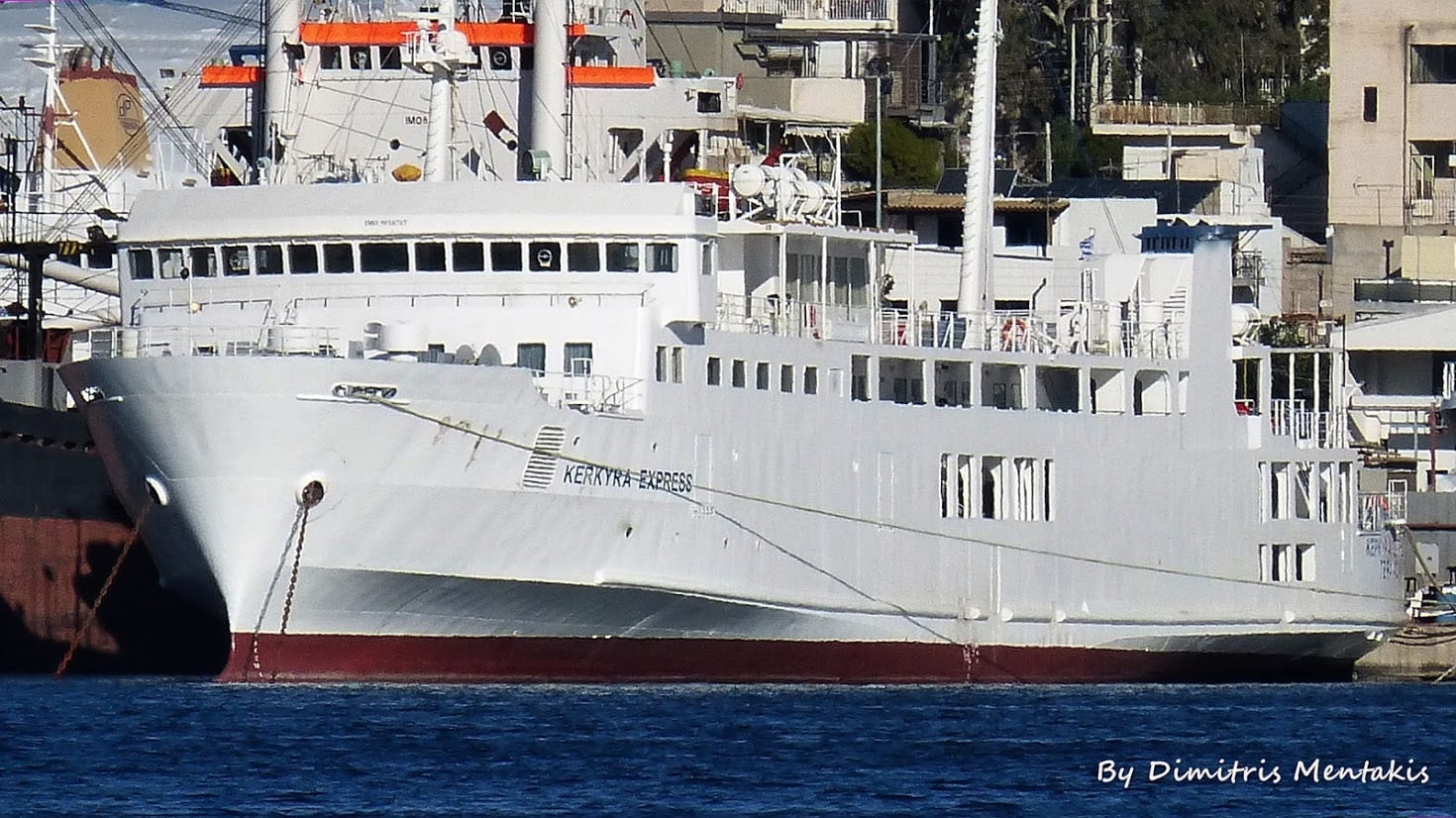
In some cases, online booking through Ferryhopper might not be available. You should be able to find passenger seats once you get there, or maybe book through the company websites.
Ionas
Built: 1989
Length: 93.8 metres
Speed: 10.8 knots
Passenger and vehicle capacity
Agios Spyridon
Built: 2000
Length: 81.5 metres
Speed: 12 knots
Passenger and vehicle capacity
Agia Irini
Built: 1970
Length: 80.4 metres
Speed: 11.6 knots
Passenger and vehicle capacity
Eleni
Built: 1970
Length: 77.8 metres
Speed: 9.7 knots
Passenger and vehicle capacity
Nanti
Built: 1973
Length: 66 metres
Speed: 11.1 knots
Passenger and vehicle capacity
Ano Hora II
Length: 104 metres
Passenger capacity: 797
Vehicle capacity: 220
Nikolaos
Length: 95.8 metres
Passenger capacity: 650
Vehicle capacity: 160
Dorieus
Length: 93.8 metres
Passenger capacity: 585
Vehicle capacity: 150
Agia Theodora
Length: 85 metres
Passenger capacity: 732
Vehicle capacity: 160
Kerkyra Express
Length: 76.6 metres
Passenger capacity: 588
Vehicle capacity: 90
Alkinoos
Length: 73.9 metres
Passenger capacity: 590
Vehicle capacity: 100
Kerkyra
Length: 72.4 metres
Passenger capacity: 478
Vehicle capacity: 90
Menekratis
Length: 70 metres
Passenger capacity: 490
Vehicle capacity: 90
Evdokia
Length: 44.4 metres
Passenger capacity: 300
Vehicle capacity: 20
For more information, and to check out some of the ferry photos, you can visit the company websites:
Corfu ferries
Kerkyra Seaways
Kerkyra Lines
17. Anes Ferries – Local routes around Greece
Anes Ferries are a small company, running small and medium-sized ferries around Greece.
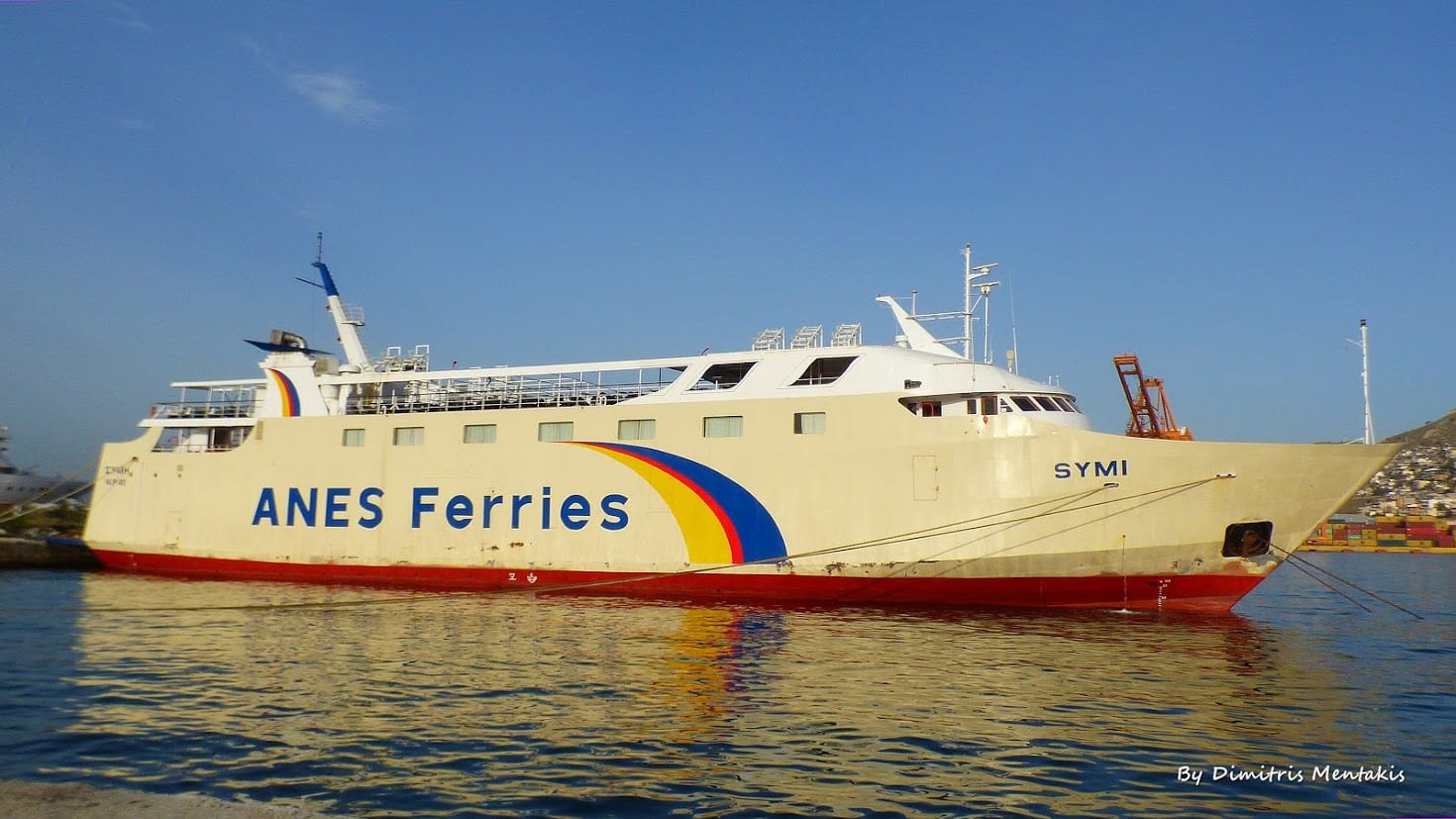
Agios Nektarios
This small ferry can carry up to 600 passengers and 90 vehicles from Piraeus to Aegina.
Proteas / Proteus
This local ferry connects Volos port to the Sporades island and Evia. Proteas is 87 metres long and can carry up to 372 passengers and 110 vehicles. There is currently news that this ferry will be used in the Alexandroupoli – Samothraki route. Watch this space!
Symi
Symi connects Agios Konstantinos Evia and Volos with the Sporades islands. It has a fairly large passenger capacity, at 780 people. There is also availability for 60 vehicles.
Sebeco
Sebeco is a small, passenger-only vessel that can accommodate up to 200 passengers. It currently travels from Rhodes to the small island of Symi.
18. Skyros Shipping Co – Evia and Sporades
Skyros Lines operates a passenger / car ferry, Achilleas, from Kymi in Evia to Skyros, Skopelos and Alonnisos. This route might not always appear on Ferryhopper.
Achilleas
Built: 1987, Japan, refurbished in 2004
Length: 96.6 metres
Speed: 14.8 knots
Passenger capacity: 600 summer / 520 winter
Vehicle capacity: 160
19. Triton / Avlemonas Ferries – Kea and Kythira
Triton Ferries operate two small ferries. Ionis departs from Lavrio port, and goes to Kea (Tzia) and Kythnos. Porfyrousa connects Neapoli in the Peloponnese, Kythira and Antikythera.

Ionis
Built: 1977, Greece
Length: 96.30 metres
Speed: 19 knots
Passenger capacity: 800
Vehicle capacity: 150
Porfyrousa
Built: 1997, Turkey
Length: 75.5 metres
Speed: 13 knots
Passenger capacity: 300
Vehicle capacity: 150
20. Goutos Lines – Athens to Kea and Kythnos
Goutos Lines run a passenger / car ferry from Lavrio port to the nearby island of Kea, or Tzia.

Macedon
Built: 1972
Length: 90 metres
Speed: 16 knots
Passenger capacity: 457
Vehicle capacity: Yes
21. Saronic ferries – Ferries to the Saronic islands
Like the name suggests, this company operates four ferries to the Saronic islands of Aegina, Agistri, Methana and Poros.
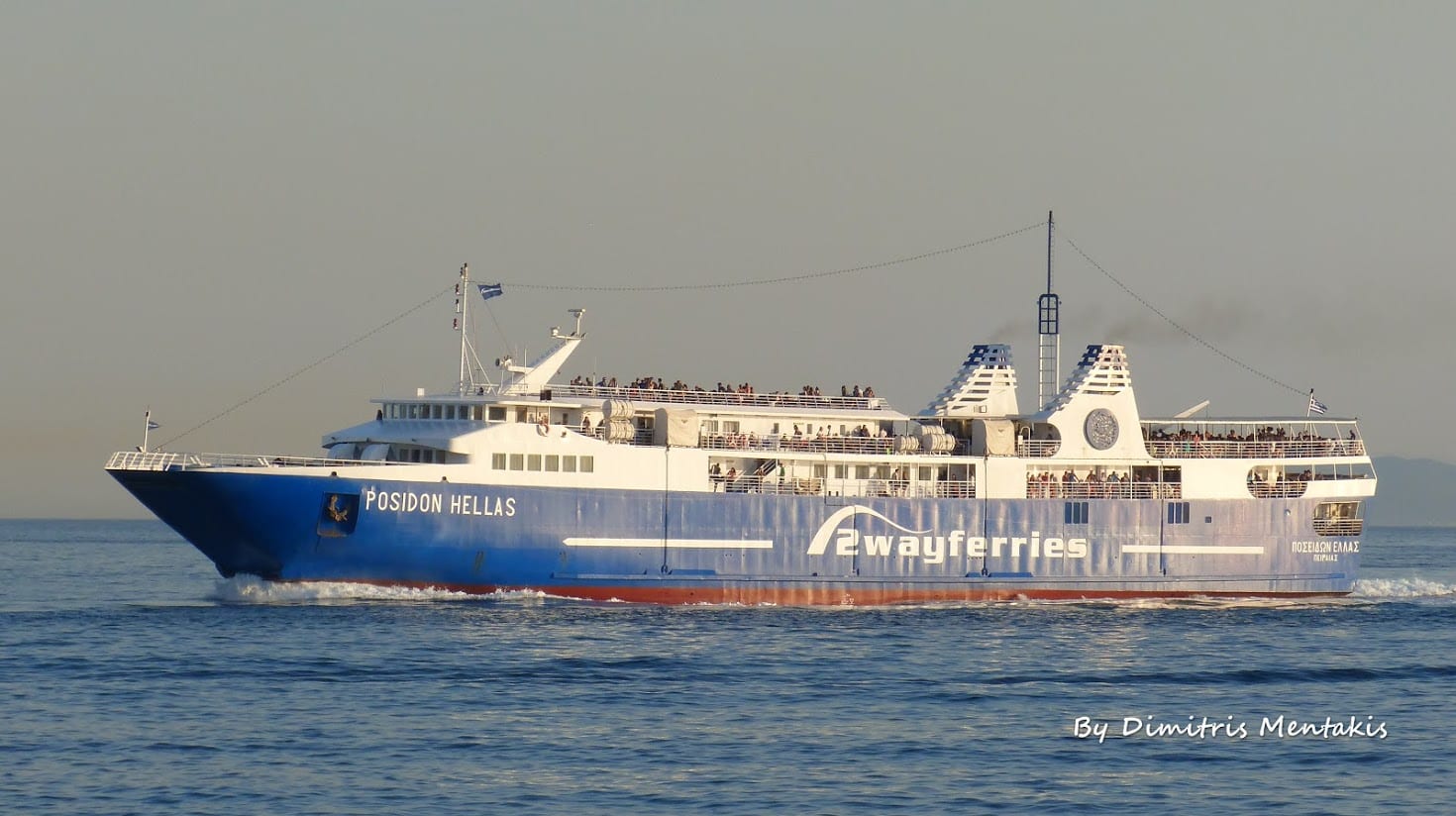
Phivos
Built: 1980
Length: 100 metres
Speed: 15.5 knots
Passenger capacity: 1,200
Vehicle capacity: 120
Apollon Hellas
Built: 1990
Length: 91.80 metres
Speed: 14.7 knots
Passenger capacity: 1,380
Vehicle capacity: 100
Achaeos
Built: 2007
Length: 87.7 metres
Speed: 14.3 knots
Passenger capacity: 1,000
Vehicle capacity: 140
Posidon Hellas
Built: 1998
Length: 86 metres
Speed: 14.9 knots
Passenger capacity: 1,300
Vehicle capacity: 74
22. Aegean Flying Dolphins – Ferries to the Saronic islands and the Sporades
These small vessels travel around the Saronic islands and the Sporades. At the time of writing, the company lists four similar flying dolphins, that are 35 metres each. They are all named after ancient Greek gods – Zeus, Hermes, Athena and Venus I.
23. Panorama – Rafina to Marmari in Evia
This company operates one ferry, called Panorama, from Rafina to Marmari in South Evia. It’s a fairly large (101 metres) ferry with passenger and vehicle capacity.
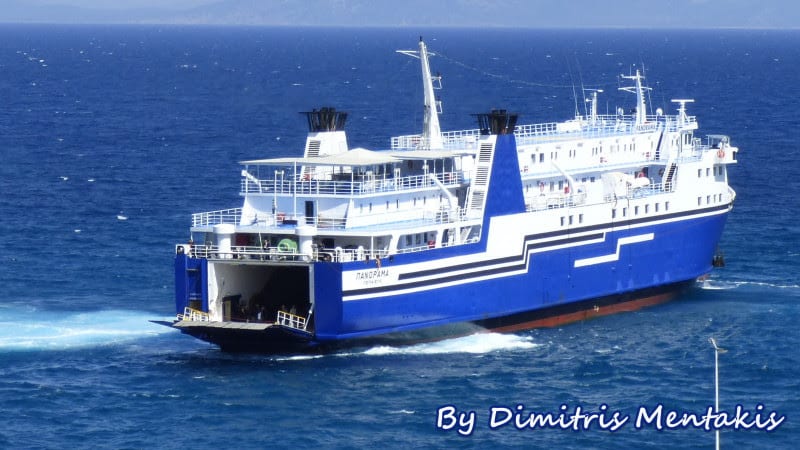
Schedules change from season to season. If you are not able to book tickets on ferryhopper, you will be able to get them directly at Rafina port. Just get there an hour earlier or so.
24. ANE Kalymnou – Rhodes to Chalki in the Dodecanese
This local company operates three vessels around the Dodecanese. It even connects some of the minor islands, though routes are not on a daily basis.
Nissos Kalymnos is a medium-sized ferry (62 metres), with passenger and vehicle capacity.
Kalymnos Star and Kalymnos Dolphin are small passenger vessels, for short trips.
For more information, check their website.
25. Dodekanisos Seaways – Dodecanese islands
This company operates one ferry and two high-speed catamarans connecting the islands of the Dodecanese.
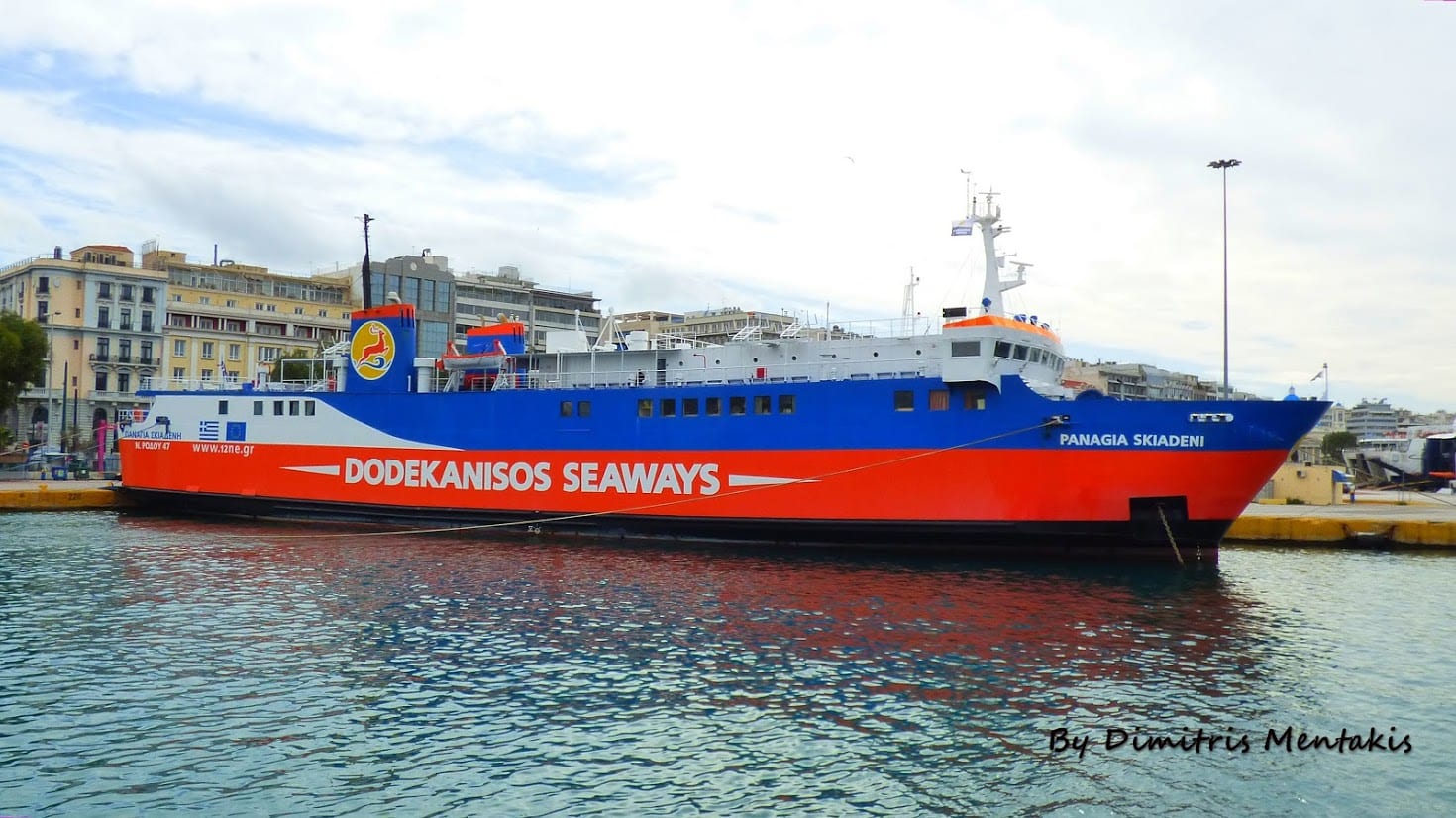
Panagia Skiadeni
Length: 83.7 metres
Speed: 16 knots
Passenger capacity: 700 summer, 590 winter
Vehicle capacity: 115
Dodekanisos Express
Length: 40 metres
Speed: 31 knots
Passenger capacity: 337
Vehicle capacity: 6
Dodekanisos Pride
Length: 40 metres
Speed: 32 knots
Passenger capacity: 280
Vehicle capacity: 9
For more information, click here.
26. Alco Ferries – Rhodes to Chalki in the Dodecanese
Alco Ferries operate the Sebeco II, running the half-hour journey from Rhodes to nearby Chalki. This 29-metre long, passenger-only ferry was built in 2019.

Check out their website (in Greek only) for a few photos.
27. Sea Dreams – Rhodes to Symi and Turkey
Sea Dreams operate small passenger catamarans from Rhodes to Symi and nearby Turkey. As timetables and routes may change from season to season, it’s best to do some further research a few days before your trip.
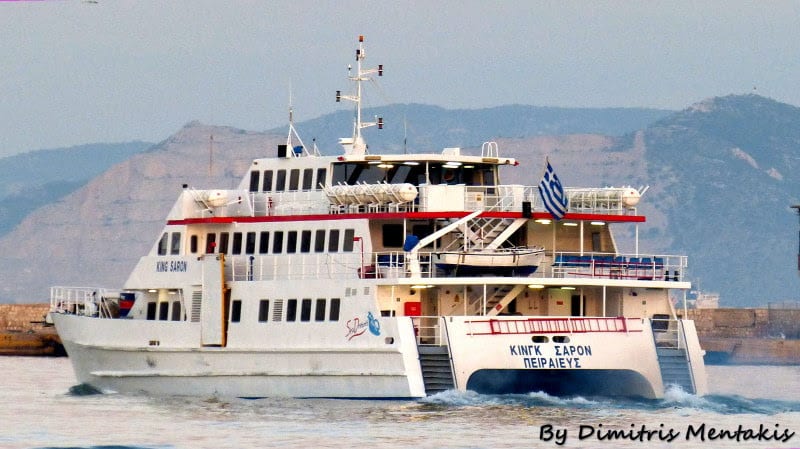
Aegean Cat
Length: 37 metres
Speed: 29 knots
Passenger capacity: 403
King Saron
Length: 36 metres
Speed: 27 knots
Passenger capacity: 510
Symi II
Speed: 14 knots
Passenger capacity: 480
28. Lafasi – Kos to Kalymnos and Turkey
This local company serves the routes from Kos to Kalymnos, as well as Kos to Bodrum in Turkey. They operate two small passenger ferries.
Apollon II
Length: 28.9 metres
Speed: 20 knots
Passenger capacity: 223
Ilias T
Length: 22.5 metres
Speed: 20 knots
Passenger capacity: 123
You can check out these small vessels here.
29. Other ferries from Greece to Turkey
The companies below only run ferries from Greece to Turkey. You can book tickets on Ferryhopper, and if you want more information on the vessels you can check their websites.
Rhodes to Fethiye – Makri Travel
Rhodes to Fethiye – Dodecanese Flying Dolphins
Rhodes to Marmaris – Yesil Marmaris Lines
Chios to Cesme – Sunrise Lines
Are there ferries from Greece to Egypt?
If you look at a map without taking into account distances, it seems like there should be a ferry from Greece to Egypt. In fact, in the past a ferry ran once or twice a week.
Updating this in 2020, there is currently no ferry running between Greece and Egypt.
Ferries in Greece
So this is it, a list of all ferries in Greece – who would have known they are so many. Hopefully it will come in handy when you are planning your next trip to Greece!
Hi Dave,
It does not look like it, but is it possible to take a ferry from the Cyclades islands (santorini maybe) to one of the Sardonic islands instead of going back to Athens and taking the ferry from there?
thanks!
Hi Kay,
I’m not aware of any unfortunately, so you’d need to get to Piraeus first and then take another ferry out from there.
Hi Dave, Is seems that when booking ferries you don’t save by booking a return or doing multi trips, it’s just double the amount or X the amount of trips so unlike here where a return works out cheaper. Is that the same with all the various ferry providers do you know? Looking at Santorini – Naxos and Naxos – Mykonos and just wondering if I will save by booking returns but it looks like this isn’t the case. Many thanks such great information on here. Thank you Charlotte
Hi Charlotte,
You’re correct – there is no cost saving for booking return trips. Wish there was though!!
Thanks Dave for sharing, great information!
First time traveler to Greece – planning a trip for late Aug 2024. How far in advance do you recommend buying ferry tickets and are all the ferry routes listed for Aug 2024 travel? Thanks!
Hi Tom,
Writing this on 26th March 2024, ’d say about 80% of the ferry routes are now listed for the summer. Most of the popular routes are, it’s still the smaller routes that are yet to list.
In particular, Zante Ferries, who operate rather confusingly in the Cyclades islands, don’t have their timetables up yet.
If you want to sail between popular islands like Mykonos and Santorini you should book your tickets as soon as possible.
Less popular routes there is less urgency, especially on the bigger boats such as Blue Star Ferries.
Dear Dave,
As many on here have posted, I am prone to sea-sickness so I will take something ahead of time if needed. I would like to take the nicest ferry possible and it seems Seajets has the best options between Paros and Mykonos, but there are 2 choices: either Tera Jet c or Super Jet 2. The Tera Jet is much larger and allows for vehicles, so therefore accommodates a lot more passengers. We will not be traveling with a car and wonder if the Super Jet 2 is a better choice since we may have less tourists (and thus chaos)?? Both ferries last about 40 minutes. Your opinion is greatly appreciated.
Hi,
Not much difference between them and it’s a short ferry journey between Paros and Mykonos.
It would be better to take the slightly larger car carrying ferry overall if sea-sickness might be an issue. They are both likely to be as equally busy depending on what time they sail and time of year etc.
Hello,
Thank you for such a helpful and informative blog on visiting Greece!
I am taking my first solo trip out to the Island of Andros in May and will be departing from the port of Rafina.
I just wanted to know what the difference is between a standard seat and a deck-lounge seat? I want to be able to sit somewhere where I can keep my luggage with me (20kg suitcase) and I’m not sure which is best to book.
Also if possible, do you have any recommendations for reliable taxi services which go between Rafina and Athens airport?
Many thanks in advance!
Hi Sophie,
For your taxi from the Airport and Rafina, you can pre-book using Welcome Pickups. Slightly more expensive than the regular airport queue taxi (by 5 euros or so), but worth it as they will meet and greet.
For your ferry crossing – just go for the cheapest ticket. In May, there will not be so many people on the ferry, so you can have your pick of the seats and sit in a more expensive one for free. Or sit in the cafe seating, which is what we sometimes do on shorter trips.
Your baggage is more complicated. Convention is that the heavy suitcase stays downstairs in the luggage area. If you try to carry it upstairs, you may be asked to leave it below.
Rule of thumb is if you are confident enough and strong enough to carry all your luggage yourself up the stairs (there may not be elevators or moving staircases), then do it. However, if the crew thinks that it will slow boarding and disembarkation for everyone else, they will insist on you leaving it below.
Mental experiment – if you were parked on the second or third floor of a car park, could you walk up the stairs easily with your luggage. If yes, you’ll be able to do it on the ferry 🙂
Hi Dave,
Thanks for your post! I’m planning to travel Athens (Piraeus) to Paros return in early September. Do the ferries later in the afternoon/evening usually run on time or are they often delayed?
Also, as someone who gets motion sickness, are the bigger Seajets ferries similar to the slower ferries in terms of bumpiness?
Thanks, Emma
Hi Emma,
Ferries leaving Piraeus almost always leave on time unless there is a major problem (and if they delay a ferry because of bad weather, you really don’t want to be on it anyway!).
I get motion sickness as well – i take a ridiculous amount of ginger tablets, ginger tea, you name it!
A conventional ferry as opposed to a catamaran type is better in the bad weather.
Thanks for this helpful info, from a first time Greece traveler. Is it really true that you need to be at the ferry dock a full hour before departure? We will likely be cruising from Piraeus to Naxos and then on to Santorini after 3 nights on Naxos. Thanks, in advance, for your thoughts.
Hi Brittnee,
If you are leaving from Piraeus for the first time, then yes – it’s better to be there an hour before because things can be quite chaotic. It just allows you a little more time.
From Naxos, you can aim to be there a half hour before.
All this should allow for traffic problems, and let you get boarded without having to rush around.
Hi Dave
Really useful information, I wish I’d found your page before!
We’re doing Athens – Milos – Santorini in late March/April but according to Ferryhopper there is only one sailing a day for each leg. Now we’re worried about cancellations, i.e. what do we do if the Milos – Santorini ferry is cancelled and we’re stuck without accommodation! What are the ferry company’s policies in this situation? Also do you think more crossings might be added later in the year?
Would really appreciate your advice in this!
Many thanks
Matt
Hi Matt,
Ferries are cancelled rarely – in bad weather delays might happen though.
Each ferry company has their own policy, which would be to normally put you on the next ferry.
At that time of year, there would be no issue picking up a hotel room for an extra night if needed.
I doubt that extra ferries would be added to these routes at this time of year, but you never know!
One other thought – all of these islands have airports, so it might be possible to get a flight back to Athens if needed.
Hi Dave,
An amazing site thank you. There are three of us doing a walking tour of Serifos, Sifnos and Milos. We will be staying three days on each island. What issues can you see about ferries between islands. We are flying out of Milos to Athens.
Hi Tony,
On May 1st there is always a ferry strike, so that could be issue number 1 if traveling then.
The main problem though, is that ferry schedules might not go live until February or March for those routes.
Hi there, I am in the early stages of planning a hopping trip next year. The ferry schedule is not released yet and I believe this does not happen until early in the year.
My question is that do the schedules tend to stay fairly consistent from season to season? I am trying to put a rough plan together of timings and formulate an idea of costs based upon current schedules. Our those plans likely to be out the window when the new schedules come out in the New Year?
Hi,
Routes (especially the most popular) tend to stay the same year after year.
Schedules (by this we mean timetables in this case) themselves do change though.
Hello!
I’m looking for your advice about timing my transportation. I land in Athens airport at 2:50pm on Saturday Sept 9th. I am trying to get to the Piraeus port to catch the last ferry at 5:30pm. Is this possible?
I am interested in using the service you recommended, Welcome Taxi, as the pre-booked taxis service to transport me to the ferry port.
So I guess I am wondering if Piraeus port is easy to get to from the airport. How far in advance do I need to arrive at the port to board the ferry (Can I arrive close to the departure time at 5:30 and still board the ferry easily or will they turn me away after a cut off time)? Is an hour a reasonable amount of time to leave the airport around 4:15pm and arrive at the ferry? If I took public transportation is there a drop off near the ferry or do you have to walk some distance to get to the ferry? Thanks for reading this. Im nervous for my first solo international trip.
Hi Sheryl,
I think it’s probably pushing it for time.
You’re relying on the flight landing on time, and then getting your baggage straight away – that’s really going to be out of your hands.
An hour’s travel from airport to Piraeus by taxi is about right, and the driver can take you directly to the gate your ferry leaves from. There is no cut off for boarding – but the ferry won’t wait when it is time to sail.
If everything goes well though, you could be at the port just as easily for 16.45 – it really depends how quick you can leaver the airport.
HI Dave, This is a great site – thank you.
We are travelling in Oct and one of our party has severe sea sickness and stays on deck. She has agreed to go on the high speed ferries, but I noticed that you made a comment that the high speed boats do not have an outside area. Did I read that correctly ? Any other suggestions ?
It will depend on the ferry route and the vessel being used, but typically the very highspeed ones do not have an outdoor area.
The only thing you can really do is take a lot of motion sickness tablets and then hope for the best there’s access to outside the ferry when onboard.
Thanks for this, Dave! Appreciated the detailed info very much. I’m planning a trip in late March 2024. There are no timetables available yet and I’m concerned about the reduced schedule in low season. I’d like to book accommodations as far in advance as possible.
Can you tell me if these routes are possible/feasible during March? If so, do ferries run daily? On certain days of the week? I’m finding conflicting information online. Would appreciate your expert opinion. Many thanks! (also completely open to suggestions)
Rhodes to Santorini (cabin/berth for 2) – around March 29
Santorini to Naxos – around March 31
Naxos to Athens (fly or ferry) – around April 3
Hi Laura,
The ferry timetables for March 2024 might not be fully available until January.
That said, there’s no danger of hotels booking out, as it’s the off season.
This year there were only two ferries a week sailing from Rhodes to Santorini in March – and these took over 24 hours!! Consider flying back to Athens, and then out to Santorini.
There’s normally one Santorini to Naxos ferry sailing a day in March
There’s normally two ferries a day sailing from Naxos to Piraeus in April – and daily flights.
Hi Dave,
Considering travelling to Herakleion by Ferry on the Blue Star Blue Horizon on 13th August instead of flying, which has become quite expensive this year. Did some research on this boat, apparently it has a pool. Would you know if that is accessable by the passengers on board? Could be one way to spend some of the time as its over 8 hours.
Hi Helen,
I haven’t heard that the Blue Star Horizon has a pool. As far as I know, no ferries sailing in Greece have pools.
However, if you take this boat and it has one, let me know and I’ll update the guides!
Hi Dave,
Thank you so much for your detailed responses! I was just about to book with SeaJets to go from Santorini to Milos, however upon your responses I am rethinking. My husband and I would like to save time (2 hrs vs. 5.5 hrs) but am now concerned about cancellations with Seajets (this would be the Speedrunner Jet though). In general, do you advise the larger ferries always despite the time difference? We are travelling the first week of Sept, for reference. Thank you so much!!
Glad you’ve found some of the things here useful – including other readers questions and experiences using the ferry system in Greece!
In general, if there are two ferries sailing in a day, and one of them is a fast ferry like SeaJets and one is a conventional ferry I prefer to take the conventional one.
However, if time is a factor (and why not make the most of what you have on vacation!), then I’d take the faster one.
I think the slower ferry you mention is the DIONISIOS SOLOMOS? It’s an old ferry, but reliable – just not as up to date as some of the others! A considerable saving in cost taking this one as well.
Hi, This is such helpful information! I am flying to Athens from July 12-July 18. We are trying to figure out the best way to structure the trip and whether to ferry or fly to a one or more of the islands. Other than not being able to travel on Saturday until after 2230, we are flexible. Do you know of any overnight, very late ferries to or from Athens? Considering Crete, Rhodes, Santorini, and open to other options. Thanks!
You can get overnight ferries to both Rhodes and Crete from Athens Piraeus Port. They are long journeys though, and best made in a cabin if you want to feel human at the end of the trip.
Considering the travel time and cost, a flight might be a better option. These longer trip ferries are better suited to people traveling with a vehicle (unless you just want the experience of traveling overnight on a ferry to the Greek islands).
We are a family of 4 traveling from Mykonos to Santorini on Aug 24. 2023. We can’t decide between flying Aegean ( 2 ½ hrs connecting in Athens ) or taking a ferry Seajets Superjet at 10 am (direct – 2 hrs), Golden Star Ferries Express jet at 10:30 (2 stops – 3 hrs)) , Seajets Express jet at 12 ( 2 stops -2 ½ hrs).
I am most concerned with trip being cancelled and being stranded with no hotel and missing a day in Santorini. Ive read that there are high winds in August.
Hi,
Difficult one to answer!
Ferries are cancelled very, very rarely due to weather… But Murphy’s Law and all that!
So, if you want absolute peace of mind, you could take the flights… you’ll lose a few hours getting to and from airports and check-in, baggage collection in Santorini. (Of course, nothing to say that on a freak weather day of 100kmh winds flights might not be delayed as well!).
My preference for ferries sailing that day might be the later Minoan Lines ferry, but thinking about it, SeaJets makes the most sense, as if there are problems they could more easily bump you to a later sailing as they have multiple boats.
An earlier ferry is better than a later one in my opinion (winds die down overnight, and pick up as the day progresses).
Hi Dave,
We need to travel from Santorini to Mykonos on 5th August. I have a sickness phobia. I’m seeing mixed reviews about the Seajets World Champion, some sources saying it’s the fastest and smoothest option and others saying the speed makes people sick. What do you think?
I think the smoothness of the trip is less to do with the boat, and more to do with the weather.
All of the ferries on the Santorini Mykonos route are high speed, and likely to experience wavy days the same way.
Hi Dave
Thanks for your site. My husband and I are planning to island hop in late June/early July from Athens to Andros-Tinos-Naxos-Mykonos. We have a few days between each island. Should we pre-book tickets online rather than just turn up at the port? How far ahead should we book? Are the ferries between islands reliable and which ferry company would you recommend? Thanks so much.
Hi,
For this year in particular, I strongly suggest booking ferry tickets as much in advance as you can.
In the Cyclades, I prefer Blue Star Ferries (or any large ferry) over the high speed ferries such as SeaJets.
The reliability for ferries is more to do with the wind conditions than anything else – the larger ferries do better in stronger winds.
Hi Dave,
Thanks for all of the helpful information. My family will be on Naxos and we would like to ferry over to Paros for the day. In order to enjoy the whole day on Paros, we were thinking about taking the 11pm ferry back to Naxos. Is it ill-advised to book the last ferry back to Naxos?
Thanks,
Suneeta
As long as you are there on time, I don’t see a problem.
There’s no reason this ship would be cancelled – it’s one of the big ones and very reliable.
Hi, Dave! This was so helpful- thank you!
In late September, our group of 4 is staying in Paros for 4 nights before going to Santorini. We would like to take a day trip to Naxos while we are based in Paros, but our travel agent has strongly advised against this due to “lack of reliability” of the ferries. This seemed odd to us and I cannot find any reason to not pursue the day trip unless the weather is poor that day. Would you have any hesitations?
Hi Megan,
I’m not sure why they would say that. there’s very few islands in Greece which are closer and have more ferry connections!
These would also be the exact same ferry companies you’d take from paros to santorini – so really not sure what they mean.
Only thing i can figure, is they don’t want you working out how to book the ferries yourself for the trip!
Anyhow, you can find ferry timetables at: Ferryhopper
Take the first ferry out to naxos in the morning. Perhaps not risk the last ferry back from Naxos to Paros (Murphy’s law and all that!), but second or third from last. Looks like you’ll have enough time in Naxos town – Unless it’s me that’s missing something!!
Hi Dave, great info here! My family will be in Greece in late July. On Ferryhopper there aren’t many options left for Santorini to Naxos on July 31st…just high speed Seajets which I am a little worried about the whole seasickness thing. Could additional trips be added by Bluestar (or other ferry lines) that day due to peak high season? Or do we just need to suck it up and book a Seajet at this point? Thanks in advance!
HI – I am seeing Blue Star Ferries on that route now… perhaps they were just added!
Dave, I am deciding if we should fly vs. ferry on July 6th from Athens to Crete. I noticed some ferries have a 2-4 hr connection in Santorini. Could we get off ferry and check out Santorini during the stop?
It’s a long trip via ferry – and a bit concerned about winds and seasickness, but we’d love to travel by boat to see the islands from the water. Thanks for your input.
Hi Shannon,
Whichever way you do it, it’s a long ride!
I would advise against getting one with a connection (an indirect route). 2 hours in Santorini gives you no time at all, taking into account leaving the port and getting back there again. With 4 hours, you could at most spend 2 hours in Fira – but what would you do with your luggage?
With the Athens to Crete ferry trip, it’s better to treat it as an overnight journey, and pay extra for a cabin so you can sleep on the way. This way you save a day of your vacation as opposed to traveling during the day.
Ferry travel in Greece is fun, but this particular route doesn’t allow much island viewing.
Hi Dave
Do ferries run from Crete to Santorini in the afternoons? We are looking at taking the ferry on July 24th as we will be flying out of Santorini the same day. As of today we can only find morning ferries.
Thanks
John
Hi John,
Crete – Santorini is all morning ferries apart from a Blue Star that sails on Sundays at night. If you are able to move your travel days it might work for you but you’d need to spend the night in Santorini and you’d be checking in at 1 or 2 in the morning!
Hi Dave, Thank you for putting together this information, was really helpful. I just wanted to ask for some advice, I am travelling to Athens > Mykonos > Paros > Santorini in Aug/Sept. I am an anxious traveller when it comes to planes and boats, I don’t do well with high wind situations as well as being stuck in the same place for long, (sounds like a mess I know) but is there a fast ferry option that also isn’t prone to being bumpy or affected by winds as much?
I know there is no magic wand but any advice would be greatly appreciated 🙂
Thank you in advance.
Hi Mary,
There’s no other option unless taking the slower ferries (assuming these are the bigger conventional ones. However between Mykonos – Paros – Santorini i believe it’s all high speed ferries.
Given your description, you could consider flying Athens to Mykonos, ferry from Mykonos to Paros, ferry from Paros to Santorini, fly from Santorini to Athens
(I recommend leaving Athens until the end of your itinerary though so there’s no rush or panic about missing flights back home because of ferry delays.
Hi Dave,
Your site is incredibly helpful. Planning a trip for this August and my partner and I have laughed at how we’re just constantly finding ourselves on your page, thank you!
Quick question about a ferry connection. We’re planning on taking the Express Skopelitis from Iraklia to Naxos before we catch a flight out of Naxos. The Express Skopelitis will get us into Naxos at 1:05p, our flight leaves Naxos at 3:20p. Are we cutting it way too close? I realize that many delays are weather based, and I’m willing to gamble a little on that. However, you (and others) mention that ferries tend to get more delayed as the day goes on. Is this typical delays of 5-20 minutes per stop, or is it quite typical to see a ferry delayed by an hour+? I know these questions depend on so many things, but appreciate any thoughts you may have. I’m okay with a little risk but just want to make sure it’s not a ridiculous transfer to try and make in the first place.
Again, thanks for your site!
Glad you’ve found the site useful – I’m trying to be omnipresent before AI takes over haha!
So to the Express Skopelitis – (and let’s not be fooled by the name, it’s not an express!!)
For me I’d feel that was cutting it a little too close. Ferry delays happen for all kinds of reasons, and once it is delayed at one port, it can’t really catch back up on the time again.
That said, the Skopelitis is less affected than others as the crew knows the ship well.
My personal golden rule is to try an be at the place I am taking a flight from the previous night just in case.
Probably not the answer you want, but might be the answer you need.
Whatever you decide on, enjoy Greece!
Hi Dave,
Thank you for your insight and thorough information! I am in the middle of planning our honeymoon for September 2023 and was planning to fly into Athens on 9/7 (stay 2 nights) then ferry to Paros on 9/9 (4 nights) – Milos on 9/13 (3 nights) – Santorini on 9/16 (3 nights) – ferry back to Athens 9/19 (stay 1 night). Would this be an okay route to do? I was looking on Ferry Hopper and it looks like there is only 1 ferry from Paros to Milos and from Milos to Santorini which is a little worrisome in case something happens and the ferry is cancelled or delayed, we would not have another option to get to the next island. Do you have any thoughts?
Thanks,
Alexa
Hi Alexa,
The route looks good to me!
Unfortunately, there’s always the possibility of delays or cancellations – the same as with air travel.
You’ve done the right thing though by having many days on each island – if you are delayed, then you lose just a few hours. if something gets cancelled they will put you on the next boat.
Boats are normally cancelled for bad weather (you really wouldn’t want to sail if the weather is bad enough for them to cancel), or strike action.
My only suggestion would be to consider a flight back to Athens from Santorini, as that is the only possible weak spot in the itinerary where a cancelled ferry could hurt you.
Hi Dave,
Can the deck be enjoyed on Zante ferries?
We are travelling to Greece next month and are looking at booking a ferry for Thursday, May 18 from Santorini to Milos. The SeaJets option, for 94€, has been available since booking the trip in January. Sure enough, more ferry schedules are becoming available and our other option is a longer ferry, via Zante, for 16€. Weighing out the pros and cons and knowing if a deck can be enjoyed is one of those items we want to consider.
Many thanks 🙂
The Zante Ferries boat has a couple of small outdoor areas you can sit in – a couple down the sides and an area at the back.
The inside is also quite comfortable.
I’d take the Zante 🙂
Hi Dave!
This is amazing information thank you! We will be going from Santorini to Paros in September and have the choice between Seajets PowerJet and 10 am or the Blue star at 3:45 pm. Ideally we want the earlier one but have read that Seajets aren’t as reliable and my husband is prone to sea sickness. What would recommend? Thank you!
Seajets are more susceptible to stronger winds – so they end up delayed or cancelled more frequently than the bigger ones.
That first Santorini to Paros ferry is pretty quick though – I’d take that if you want to make the most of your vacation time. No breakfast for hubby and plenty of ginger tablets!!
Hi Dave, Thanks for your very informative and very helpful guides. My wife and I are travelling this coming mid-May flying into Athens. We will be spending three nights here before making our way across to Santorini by ferries. We are looking to stop on the way there and back to break up the long journeys. Can you recommend which two islands to visit – I’m thinking of Naxos, Paros and/or Syros. As foot passengers would we need to book up early for these ferries at this time of the year? Also booking accommodation – apart from Santorini, do we need to book up in advance?
Hi Steve,
For mid-May you don’t need to book hotels tremendously in advance and you don’t need to book ferries far in advance at all. Even the night before would be fine – the only thing with hotels, is that you might have less choice, normally on the more affordable places.
Either Naxos or Paros are great – I prefer Naxos, but actually in mid-May Paros is very nice as well.
As they are reasonably similar, you’d probably be better off going to just one of them.
If you stop at Syros, you would only need one full day there really as Syros is all about the main town Ermoupoli (Naxos and Paros have way better beaches).
Thanks for great information!
Just wondering – where can I find the cancellation policies for the ferry companies? I checked on Seajets website – they have information dated 2020 and says that refunds are only given by the “issuing agency”. What does that mean?
In your experience, do most ferry lines offer a flexible cancellation fare, or should I wait closer to my vacation in September to purchase a ticket?
Hi Barbara,
I always book through Ferryhopper. We had to cancel a ferry a week before and got a refund ok.
If you are traveling in September, and you only need foot passenger tickets, you can wait a while until booking.
We normally book ferries a couple of weeks before outside of August.
Hi Dave. I am struggling to find information on routes from Crete (all ports) to Rhodes. We are in Crete in early Oct and want to get to Rhodes. We ideally don’t want to fly as its quite expensive and takes the fun away from a ferry ride. Any information would be greatly appreciated. Thanks.
Hi Harry,
In October I think only the Prevelis makes that journey – And it’s about 15 hours or something like that!
They sailed Heraklion to Rhodes twice a week in October last year. Unfortunately, they haven’t put their schedules up this year for as far forward as October. Their schedules for October might not go live for several months yet.
ferryhopper shows a Santa Irini ferry going from Heraklion to Santorini in May. I gather it is operated by Panhellenic Lines or Horizon Sea Lines. I am, however, unable to find out from which part of the Heraklion Ferry Terminal they depart and where I would need to check-in etc.
As far as I know, all the ferries leave from the same area in Heraklion port. If you get there in plenty of time, it shouldn’t be an issue finding where you need to be, although if in doubt either email ferryhopper or the ferry company directly. You could perhaps also get a taxi ride down from your hotel and they will take you straight there.
Assuming you get issued an e-ticket, no further check-in is needed. You just need to be there in plenty of time (at least half hour before departure for foot passengers).
First thank you for taking the time to provide this information. Very informative.
Question, We will be traveling (4 adults) with a 2 yr old by ferry from Paros to Santorini (luggage and all). Does it make sense to take the Blue Star Ferry with cabins and take longer to get to Santorini versus taking the Seajet and save and hour? I considered getting VIP or Business Class seats so we could all be together and entertain her but it appears they prefer not to have such young children in these areas. I was not able to select a ticket for her with her real age and if I changed her age later it asked for everyone”s birthdays and caught the mismatch. Suggestions? I am looking for the most relaxing way given we will have all our bags and a toddler.
Hi,
When boarding ferries, you leave your larger cases downstairs as you board – the reason is that hundreds of people trying to carry 3 pieces of luggage each up the stairs in the ferry would be chaos.
So, plan to have what you need with you for the ferry trip in the equivalent of carry on baggage as you would for a plane.
For the Paros to Santorini crossing, I don’t think it’s worth cabin or business for relatively short crossings like these.
My advice – send two quick adults who’s mission it is to get on the ferry first, and claim a table in the cafe area so you have plenty of room to sit together!
The Blue Star, while slower, will have more room on and will also be less affected by winds which could be good if any of your party have sea sickness.
We need to travel from Crete to Santorini on May 1. Do ferries run on this holiday? We have luggage that us bigger than a carryon and so concerned about u t flying.
Hi Stacey,
This is traditionally a national strike day. I would advise against making travel plans in Greece on May 1st on ferries.
Hi there,
Thanks for all this good info. We were planning on travelling from Kos to Santorini end of June but have seen that there is no longer a direct ferry- do you think they may recommence this route closer to the time or should we be finding an alternative route?
Thanks!
Ella
Hi Ella,
To the best of my knowledge this route no longer operates.
You could see if going from Kos to Syros and then Syros to Santorini is worthwhile for you.
Another alternative would be to fly Kos to Athens, and then fly or ferry Athens to Santorini.
Hi Dave,
Love your posts. One last question on Greek ferries: do I need to show my passport to board? If not, I can carry it in an underclothing pouch. If so, I cannot.
Thanks!
Hi Ann,
I’ve never been asked to show a passport on ferries (apart from 2020 during the first Covid months).
All you need is the ferry ticket either physical or as a PDF on your phone and you’re good to go.
Hi Dave,
Huge task you’ve undertaken for us to benefit from! Thanks a million! I am trying to find out defintiive and reliable information on a silly return trip from Rafina to Andros in August. I have consulted three ferry search engines (Ferryhopper, Ferries in Greece and Greek Ferries) and they return very different results. The information does not match (ferries have different times, or do not appear at all in some engines). Is it because it’s too early? When will it be not too early? How can I know which ferries will go ahead as scheduled (by which engine)?
Do you have any tips or recommendations?
Thanks in advance!
Hi Luigi,
From those sites I would only trust Ferryhopper.
They only put live the schedules once they have officially been released.
If you’re trying to put a day trip together for a return on the same day, it looks like it is possible using fast Ferries.
Hi Dave!
Thank you so much for this detailed wonderful information! We are trying to go from Crete to Santorini, in early April, but there’s no fast ferries available. Since we plan to be in Santorini for a short time, we wanted to take a fast ferry there. Do you know if they add ferries to the schedule closer to the dates?
Thank you so much!
Hi Selma,
Unfortunately it looks like the faster ferries between Crete and Santorini don’t start until 12th April this year.
I don’t expect there to be any others added based on last year’s schedules (then, it was also SeaJets onve a day but it start sailing around the 20th April, so this year it’s earlier)
Potentially, a slower boat once per week might get added to the schedule. Prevelis usually sails on a Sunday but isn’t showing up yet for April.
If you want to sail before the 12th and not in a Sunday, your options are pretty limited to getting back to Athens and then getting back out to Santorini using flights.
Hi Dave. Thank-you for this incredibly detailed account of the ferries for Greece! Lots of great information here to help with planning. We are looking at a slow ferry trip to Folegandros and it seems that Zante ferries is the option (I am prone to motion sickness, so a large, slow ferry is what we need to take). We cold possibly go to Milos first, but unsure of how much time needed to then catch another ferry over to Folegandros, as we don’t really want to arrange accommodations on Milos for a night. Any thoughts? Also, I am hoping you can answer a question regarding passports – do you have to surrender your passport to the crew on each ferry trip? I have seen various posts out there, that passports are taken by a crew member and then in order to get it back, tourists are charged money (a scam). What actually happens with your passport?
Thanks so much for your time.
Hi Jo-Ann,
So dealing with the passport issue first. You never have to give your passport to anyone on the ferry when traveling within Greece. Not sure where you read that, perhaps it was for a ferry between Italy and Greece where it may have been the case.
Once you have been on one ferry, you will instantly see how impossible and impractical it would be – it’s organized chaos getting on and off the ferries!
In short – no, don’t give your passport to anyone on the ferry. You won’t even asked to show it now there are no Covid restrictions.
Regarding Folegandros – a popular travel option is to fly Athens to Santorini, and then take a ferry to Folegandros in order to save time. You could also fly to Milos first, and then take a ferry from Milos to Folegandros.
The Zante ferry from Athens (I think that’s where you mean to start?) to Folegandros would be around 8 hours – it’s quite a long time, so to cut it down by flying part of the route would give you more vacation time perhaps.
Hi Dave. We are planning to Island hop mid September to October in the less frequented Cyclades. We fly into Santorini but the price of the ferries to get off to Folegandros or Milos seems high at 64 euros per foot passenger. Will there be cheaper ferries published later in the season? I thought that there was a standard price per distance.
Hi Louise,
The price for ferries is set by the company unless it is a subsidized route.
So, SeaJets will typically have the most expensive tickets (they only operate in the tourist season).
On this Santorini to Folegandros route, Zante Ferries are also likely to run twice a week and their fare is typically cheaper (it may be subsidized – not quite sure).
The only problem is that Zante Ferries never put their routes up very far in advance. I wouldn’t expect it to go live until after Greek Easter for the period you want to travel.
Hi Dave
I find your insight great as we prepare form our first trip to Greece this June. I have seen your replies for those with seasickness concerns. I was considering the SeaJet World Champion 1 since it looks larger. However, I am concerned still. We are flying for most other islands but thought about ferry from Santorini to Mykonos. What are your thoughts?
Hi Melanie,
Unfortunately there’s no other way to get between Santorini and Mykonos, and none of the ferries on that route have outside decks I believe.
All I can suggest is a light breakfast, eat plenty of ginger, don’t look at the phone, eyes closed and meditate – at least that’s how I get through some of the ferry trips as I am the world’s worst sailor!!!
Hi Dave. Excellent site! I’ve read conflicting information about the availability of ferries in March. We will be in Greece next month and plan to go from Athens to Crete, Crete to Santorini and Santorini back to Athens. Will we be able to book a ferry in March? It looks like the various sites such as go-ferry.com allows us to book, but I want to make sure there will actually be a ferry to take. Any help would be appreciated!
Hi Troy,
Glad you’ve found the site useful!
Ferries from Crete to Santorini are questionable in March. Athens to Crete is no problem, but it might be easier to fly.
In the summer, variations of the Athens – Santorini – Crete island hopping itinerary are possible, but before April it is much more difficult.
You might find yourself flying Athens to Crete, flying back to Athens, then getting a ferry or flight to Santorini and then back again.
Personally, I would only book a ferry when they appear on either Ferryhopper or Ferryscanner. The other sites are not as good or as reliable in my opinion.
Dear Dave, We are travelling from Rafina to Andros on 4th August. My main concern is sea sickness after a very bad experience on a smallish, enclosed, fast catamaran. The options for this journey are Golden Star Superferry, Fast Ferries Andros, Fast Ferries Theologos P or Seajets Tera Jet. I am thinking that the slowest – Fast Ferries Andros – is probably my best bet. What do you think?
Either that or the Golden Star would be my choice!
Those smaller faster ferries are horrible in strong winds – and August can certainly have them!
Recommend eating lots of dried ginger before you board!
Great guide thank you! My husband and I will be coming to Greece and plan to go to Santorini, then Syros, then Hydra. SeaJet, which operates Santorini-Syros and Syros-Piraeus looks like it gets a lot of complaints and is delayed often. A delay isn’t problematic when going from Santorini to Syros but for going Syros-Piraeus-Hydra, a delay from Syros-Piraeus would be problematic. There is a SeaJet that goes Syros-Piraeus from 3 pm to 5 pm but a Fast Ferries from Syros-Piraeus from 1:35 pm to 4:20 pm. (The SeaJet is not only quicker but actually 10 euros cheaper.) Our next ferry, from Piraeus to Hydra would be 6:30 pm-8:30 pm. I had thought 1.5 hours would be enough time for the connection in Piraeus and so would could take SeaJets (which is quicker and cheaper), but now I am worried about the delays with that line. Do you have insight/experience with SeaJets in terms of delays/cancellations, vs. Fast Ferries? Thank you!
Hi Stacey,
I would say that most of the delays are to do with weather – which is really out of everyone’s hands!
I think SeaJets seem to have more complaints mainly because it is visitors to Greece using them in the majority.
Personally, I would say that leaving just 1.5 hours between ferries is a little tight. I would take the earlier ferry.
Another note: It might be worth researching where your Hydra ferry leaves from. It may be in a different area in Piraeus port, and the port is a big place, so you might have additional transfer time between gates.
Hello Dave — This is so helpful. I have a very specific question. We will be traveling from Rafina to Paros in late June. Our choices are: Golden Star Ferry SuperExpress at 7:15am (4 hr ride), FastFerries Andros at 7:30am (6 hr 20 min ride), or Sea Jets Tera JetC at 2:50pm (4 hr ride). Our first choice would be the SuperExpress due to the timetable, but it looks like a fully enclosed and maybe kind of small boat? I’m worried about seasickness for my kids (but probably curable with some Dramamine) and comfort for my 70-something parents and aunt. Any advice on which boat will be most comfortable, and/or offer the ability to be outside on a deck? Thank you!!!
Hi Grace,
I’d personally go for the quickest and best timed ride just to get the ferry trip out of the way!
These are all large boats and also carry vehicles, but not all of them you can go outside.
I think only Fast Ferries Andros you can go outside on as it has a small outdoor area.
Hi Dave,
Thanks for this really informative article!
I’m travelling between Athens and Santorini in May this year. I’m debating whether to get the seajets ferry which is 4hr45 or the longer blue star one which is 8 hours? For such a long trip would you recommend blue star as it’ll be smoother? I’m a little worried about sea sickness – though at this time of year will the waters be rough? I’m also tempted by the fact that the longer ferry allows walking out on the deck which might be nicer than being cramped indoors for 5 hours. Any advice would be much appreciated!
Hi Mira,
With the Blue Star you can go out on to the deck. With the SeaJets I don’t think you can go out at all so perhaps something to keep in mind.
There’s no predicating the wind, but generally, the Meltemi winds (very strong winds!) start July/August so you should be ok.
If you only have limited time, and seasickness is an issue, it might be worth considering flying from Athens to Santorini – it would be a lot quicker!
Hi Dave.
We are planning a trip in August. We are flying to Rhodes. From there I would like to go to Patmos. I would also like to go to Santorini after Patmos. What would be the best way to get there?
Hi Michel,
It’s an unfortunate combination of islands that looks like it’s not possible to do at this stage.
There’s at least one ferry a day from Rhodes to Patmos – it takes about 5 hours. You can find the schedule and get tickets here: Ferryscanner
Getting to Santorini from Patmos is more of a problem – there’s nothing scheduled and no easy way to do it. In fact, it looks like you’d have to go all the way back to Piraeus in Athens and then back out again to Santorini!
Hi Dave. My husband (also Dave 😉 and I are traveling to Greece in September 2023. I am looking at high speed ferry options from Piraeus to Naxos. A couple of questions: 1) Aside from a 30-min time difference, is there any advantage of one over the other with SeaJet WorldChampion versus Hellenic HighSpeed 4? 2) VIP seating on the HighSpeed 4 is about 30 Euro less per person…. Is there a reason? 3) When I go to book the HighSpeed 4, it says we may not be sitting together in the VIP area. Is this nothing to be concerned about? 4) I was looking at VIP assuming we would have more elbow room and a better view. Is that an accurate assumption? 5) If I needed to make a change, is it easier if I book direct through the Ferry line vice on FerryHopper? 6) Do both Seajet and Hellenic offer etickets now?
Hi Elaine,
There’s not really much between them in terms of service, so it probably makes sense to go with the one who’s schedule is best for you.
Personally I prefer the Hellenic Seaways 🙂
The VIP area may not have numbered seating, which is why they put that they can not guarantee you sitting together. The other seating is numbered though.
VIP is definitely less crowded and more comfortable. The view is a ‘depends’ answer!
Both offer e-tickets so when you book online you’ll be given a QR card which you can print off or keep on your phone as a pdf
Hi, thanks for the write-up. Very informative and very helpful. My only question comes as to booking for two people – could I book a ‘Cabin bed with window’ for myself and an economy seat ticket for the other person and then have them join me in the cabin the whole ride? Or… do both need the tix to explicitly say ‘Cabin with Window’ ticket?
Thanks in advance!
It’s unclear what might happen – if you book just the one bed, you might have the cabin to yourself. Or, you might end up sharing – I’m really not sure!
If you did end up in the cabin by yourself, yes the other person can easily join you.
Traveling from Santorini to Paros why would I want to take the slower ferry vs one of the high speed
I understand the slower ferry is larger and would be smoother ride aside from that are there reason to take the slower ferry
A smoother ride in rougher weather – also the slower ferries are normally cheaper as well. In this case, just checking a random date, 20 Euros a ticket cheaper. So if you are a family of 4 travelling, the saving could be worth it for just an hour difference in travel time.
Hi Dave, myself and my family (4 people) are travelling to Athens-Paros-Crete-Naxos on the 14th August. When I went to book ferries online via ferry scanner, for all 4 of us, they came up as 1200 euros all in – this seems very expensive. do you think it is better to book them in person when we get there?
Wow – That’s a lot!
Were these all on high speed boats by SeaJets? If so it sounds likely.
You would average as 100 Euro per person per ferry ride using SeaJets.
However if you tried the route you just mentioned you are going back on yourself which might be bumping the cost up – the better route Athens-Paros-Naxos-Crete. It might reduce the cost a little.
Try also Ferryhopper, but I think you’ll find the prices will be the same.
Wherever possible, use Blue Star Ferries who tend to have the cheaper prices.
As far as I am aware, there is no advantage in terms of cheaper tickets to buying in person. There’s only the risk you might find a boat is sold out.
You could also try going to the SeaJets site directly to see if there are any discounts or reward cards that might compensate for some of the cost.
Great wrap-up, Dave. You don’t say anything here about reliability. I know it’s popular on the forums to recommend returning to the mainland a day before a flight. I’m planning on taking a conventional ferry. from Tinos to Rafina, first week of October, not for a flight, but to meet my friends who are arriving on a flight. I’m really torn between returning a day early for security, or enjoying another night on Tinos and hoping for the best. What are the odds of a conventional ferry not sailing in October, do you think? Thanks!
Hi Sheila,
For the ferries from Tinos to Rafina to be cancelled it would have to be very strong winds. I would say ferries get cancelled due to strong winds like this a couple of times a year. Winds blow strongest in August.
In general, if you monitor the weather a few days before you are due to sail, you’ll work out if it would be cancelled or not. I recommend https://www.meteo.gr/ for more localized weather forecasts.
Hi Jenny – I’d say booking in advance is best where possible for ferries to or from Santorini in July. It will save a lot of chaos at the port trying to buy a ticket. Looks at the moment that the last ferry each day is the Blue Star leaving at 15.30. You can pre-book tickets at: Ferryscanner
Hi!
We would like to take a ferries from Italy to Greece, preferably Ancona to Patras, with our dog in the cabin.
In your experience, what are the cabins like on the Minoan and Suerfast ferries? I have read some dreadful reviews saying people don’t get the cabin they booked, that the ferries are often extremely late arriving for boarding, cabins are dirty.
I am now worried, because of our large hound!
Thank you in advance.